Catching Up with TRAPPIST-1 9 Dec 9:51 AM (yesterday, 9:51 am)
Let’s have a look at recent work on TRAPPIST-1. The system, tiny but rich in planets (seven transits!) continues to draw new work, and it’s easy to see why. Found in Aquarius some 40 light years from Earth, a star not much larger than Jupiter is close enough for the James Webb Space Telescope to probe the system for planetary atmospheres. Or so an international team working on the problem believes, with interesting but frustratingly inconclusive results.
As we’ll see, though, that’s the nature of this work, and in general of investigations of terrestrial-class planet atmospheres. I begin with news of TRAPPIST-1’s flare activity. One of the reasons to question the likelihood of life around small red stars is that they are prone to violent flares, particularly in their youth. Planets in the habitable zone, and there are three here, would be bathed in radiation early on, conceivably stripping their atmospheres entirely, and certainly raising doubts about potential life on the surface.
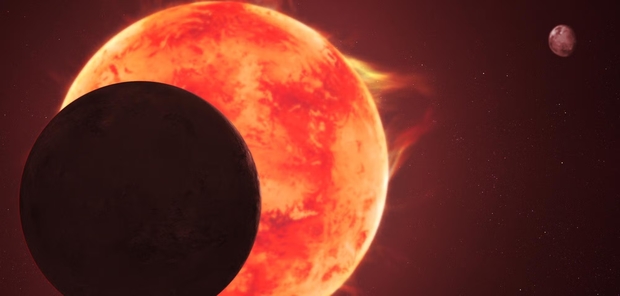
Image: Artist’s concept of the planet TRAPPIST-1d passing in front of the star TRAPPIST-1. Credit: NASA, ESA, CSA, Joseph Olmsted/STScI.
A just released paper digs into the question by applying JWST data on six flares recorded in 2022 and 2023 to a computer model created by Adam Kowalski (University of Colorado Boulder), who is a co-author on the work. The equations of Kowalski’s model allow the researchers to probe the stellar activity that created the flares, which the authors see as deriving from magnetic reconnection that heats stellar plasma through pulses of electron beaming.
The scientists are essentially reverse-engineering flare activity with an eye to understanding how it might affect an atmosphere, if one exists, on these planets. The extent of the activity came as something of a surprise. As lead author Ward Howard (also at University of Colorado Boulder) puts it: “When scientists had just started observing TRAPPIST-1, we hadn’t anticipated the majority of our transits would be obstructed by these large flares.”
Which would seem to be bad news for biology here, but we also learn from Kowalski’s equations that TRAPPIST-1 flares are considerably weaker than supposed. We can couple this result with two papers published earlier this year in the Astrophysical Journal Letters. Using transmission spectroscopy and working with JWST’s Near-Infrared Spectrograph and Near-Infrared Imager and Slitless Spectrograph, the researchers looked at TRAPPIST-1e as it passed in front of the host star. A third paper, released on December 5, examines these data and the possibility of methane in an atmosphere. Here we run into the obvious limitations of modeling.
The most recent paper is out of the University of Arizona, where Sukrit Ranjan and team have gone to work on methane in an M-dwarf planet atmosphere. With an eye toward TRAPPIST-1e, they note this (italics mine):
We have shown that models that include CH4 are viable fits to TRAPPIST-1e’s transmission spectrum through both our forward-model analysis and retrievals. However, we stress that the statistical evidence falls far below that required for a detection. While an atmosphere containing CH4 and a (relatively) spectrally quiet background gas (e.g., N2) provides a good fit to the data, these initial TRAPPIST-1 e transmission spectra remain consistent with a bare rock or cloudy atmosphere interpretations. Additionally, we note that our “best-fit” CH4 model does not explain all of the correlated features present in the data. Here we briefly examine the theoretical plausibility of a N2–CH4 atmosphere on TRAPPIST-1 e to contextualize our findings.
Should we be excited by even a faint hint of an atmosphere here? Probably not. The paper simulates methane-rich atmosphere scenarios, but also discusses alternative possibilities. Here we get a sense for how preliminary all our TRAPPIST-1 work really is (and remember that JWST is working at the outer edge of its limits in retrieving the data used here). A key point is that TRAPPIST-1 is significantly cooler than our G-class Sun. As Ranjan points out:
“While the sun is a bright, yellow dwarf star, TRAPPIST-1 is an ultracool red dwarf, meaning it is significantly smaller, cooler and dimmer than our sun. Cool enough, in fact, to allow for gas molecules in its atmosphere. We reported hints of methane, but the question is, ‘is the methane attributable to molecules in the atmosphere of the planet or in the host star?…[B]ased on our most recent work, we suggest that the previously reported tentative hint of an atmosphere is more likely to be ‘noise’ from the host star.”
The paper notes that any spectral feature from an exoplanet could have not just stellar origins but also instrumental causes. In any case, stellar contamination is an acute problem because it has not been fully integrated into existing models. The approach is Bayesian, given that the plausibility of any specific scenario for an atmosphere has an effect on the confidence with which it can be identified in an individual spectrum. Right now we are left with modeling and questions.
Ranjan believes that the way forward for this particular system is to use a ‘dual transit’ method, in which the star is observed when both TRAPPIST-1e and TRAPPIST-1b move in front of the star at the same time. The idea is to separate stellar activity from what may be happening in a planetary atmosphere. As always, we look to future instrumentation, in this case ESO’s Extremely Large Telescope, which is expected to become available by the end of this decade. And next year NASA will launch the Pandora mission, a small telescope but explicitly designed for characterizing exoplanet atmospheres.
More questions than answers? Of course. We’re pushing hard against the limits of detection, but all these models help us learn what to look for next. Nearby M-dwarf transiting planets, with their deep transit depths, higher transit probability in the habitable zone and frequent transit opportunities, are going to be commanding our attention for some time to come. As always, patience remains a virtue.
Here’s a list of the papers I’ve discussed here. The flare modeling paper is Howard et al., “Separating Flare and Secondary Atmospheric Signals with RADYN Modeling of Near-infrared JWST Transmission Spectroscopy Observations of TRAPPIST-1,” Astrophysical Journal Letters Vol. 994, No. 1 (20 November 2025) L31 (full text).
The paper on methane detection and stellar activity is Ranjan et al., “The Photochemical Plausibility of Warm Exo-Titans Orbiting M Dwarf Stars,” Astrophysical Journal Letters Vol. 993, No. 2 (3 November 2025), L39 (full text).
The earlier papers of interest are Glidden et al., “JWST-TST DREAMS: Secondary Atmosphere Constraints for the Habitable Zone Planet TRAPPIST-1 e,” Astrophysical Journal Letters Vol. 990, No. 2 (8 September 2025) L53 (full text); and Espinoza et al. “JWST-TST DREAMS: NIRSpec/PRISM Transmission Spectroscopy of the Habitable Zone Planet TRAPPIST-1 e,” Astrophysical Journal Letters Vol. 990, No. 2 (L52) (full text).

The Rest is Silence: Empirically Equivalent Hypotheses about the Universe 1 Dec 10:52 AM (9 days ago)
Because we so often talk about finding an Earth 2.0, I’m reminded that the discipline of astrobiology all too easily falls prey to an earthly assumption: Intelligent beings elsewhere must take forms compatible with our planet. Thus the recent post on SETI and fireflies, one I enjoyed writing because it explores how communications work amongst non-human species here on Earth. Learning about such methods may lessen whatever anthropomorphic bias SETI retains. But these thoughts also emphasize that we continue to search in the dark. It’s a natural question to ask just where SETI goes from here. What happens if in all our work, we continue to confront silence? I’ve been asked before what a null result in SETI means – how long do we have to keep doing this before we simply acknowledge that there is no one out there? But a better question is, how would we ever discover a definitive answer given the scale of the cosmos? If not in this galaxy, maybe in Andromeda? If not there, M87?
In today’s essay, Nick Nielsen returns to dig into how these questions relate to the way we do science, and ponders what we can learn by continuing to push out into a universe that remains stubbornly unyielding in its secrets. Nick is an independent scholar in Portland OR whose work has long graced these pages. Of late he has been producing videos on the philosophy of history. His most recent paper is “Human Presence in Extreme Environments as a Condition of Knowledge: An Epistemological Inquiry.” As Breakthrough Listen continues and we enter the era of the Extremely Large Telescopes, questions like these will continue to resonate.
by J. N. Nielsen

What would it mean for humanity to be truly alone in the universe? In an earlier Centauri Dreams post, SETI’s Charismatic Megafauna, I discussed the tendency to focus on the extraterrestrial equivalent of what ecologists sometimes call “charismatic megafauna”—which in the case of SETI consists of little green men, space aliens, bug-eyed monsters, Martians, and their kin—whereas life and intelligence might take very different forms from those with which we’re familiar. [1] We might not feel much of a connection to the discovery of an exoplanet covered in a microbial mats, which couldn’t respond to us, much less communicate with us, but it would be evidence that there is other life in the universe, which suggests there may be other life yet to be found, which also would mean that, as life, we aren’t utterly alone in the universe. This in turn suggests the alternative view that we might be utterly alone, without a trace of life beyond Earth, and this gets to some fundamental questions. One way to cast some light on these questions is through a thought experiment that would bring the method of isolation to bear on the problem. I will focus on a single, narrow, unlikely scenario as a way to think about what it would mean to be truly alone in the universe.
Suppose, then, we find ourselves utterly alone in the universe—not only alone in the sense of there being no other intelligent species with whom we could communicate, and no evidence of any having existed in the universe’s past (from which we could experience unidirectional communication), but utterly alone in the sense that there’s not any sign of life in the universe, not even microbes. This scenario begins where we are today, inhabiting Earth, looking out into the cosmos to see what we can see, listening for SETI transmissions, trying to detect life elsewhere, and planning missions and designing spacecraft to extend this search further outward into the universe. This thought experiment, then, is consistent with what we know of the universe today; it is empirically equivalent to a universe positively brimming with other life and other civilizations that we just haven’t yet found; at our current level of technology and cosmological standing, we can’t distinguish between the two scenarios.
There is a cluster of related problems in the philosophy of science, including the underdetermination of theories, the possibility of empirically equivalent theories, theory choice, and holism in confirmation. I’m going to focus on the possibility of empirically equivalent theories, but what follows could be reformulated in terms of the others. What is it for a theory to be underdetermined? “To say that an outcome is underdetermined is to say that some information about initial conditions and rules or principles does not guarantee a unique solution.” (Lipton 1991: 6) If there’s no unique solution, there may be many possible solutions. Empirically equivalent theories are these many possible solutions. [2]
The discussion of empirically equivalent theories today has focused on the expansion of the consequence class of a theory, i.e., adopting auxiliary hypotheses so as to derive further testable consequences. We’re going to look at this through the other end of the telescope, however. Two theories can have radically different consequence classes while our ability conduct observations that would confirm or disconfirm these consequence classes is so limited that the available empirical evidence cannot distinguish between the two theories. That our ability to observe changes, and therefore the scope of the empirical consequence class changes, due to technologies and techniques of observation has been called “variability of the range of observation” (VRO) and the “inconstancy of the boundary of the observable.” (discussed in Laudan and Leplin 1991). Given VRO, there may be a time in the history of science when the observable consequence classes of two theories coincide, even while their unobservable consequence class ultimately diverges; at this time, the two theories are empirically equivalent in the sense that no current observation can confirm one while disconfirming the other. This is why we build larger telescopes and more powerful particle accelerators: to gain access to observations that can decide between theories that are empirically equivalent at present, but which have divergent consequence classes.
Returning to our thought experiment, where we began as we are today (unable to distinguish between a populous universe and terrestrial exceptionalism)—what do we do next? In our naïveté we make progress with our ongoing search. We build better telescopes, and we orbit larger and more sophisticated telescopes, with the intention of performing exoplanet atmospheric spectroscopy. We build spacecraft that allow us to explore our solar system. We go to Mars, but we don’t find anything there; no microbes in the permafrost or deep in subterranean bodies of water, and no sign of any life in the past. But we aren’t discouraged by this, because it’s always been possible that there was never life on Mars. There are many other places to explore in our solar system. Eventually we travel to interesting places like Titan, with its own thick atmosphere. We find this moon to be scientifically fascinating, but, again, no life of any kind is found. We send probes into subsurface liquid water oceans, first on Enceladus, then Europa, and we find nothing more complex in these waters than what we see in the astrochemistry of deep space: some simple organic molecules, but no macromolecules. Again, these worlds are scientifically fascinating, but we don’t find life and, again, we aren’t greatly bothered because we’ve only recently accustomed ourselves to the idea that there might be life in these oceans, and we can readily un-accustom ourselves as quickly. But it does raise questions, and so we seek out all the subsurface oceans in our solar system, even the brine pockets under the surface of Ceres, this time with a little more urgency. Again, we find many things of scientific interest, but no life, and no other unexpected forms of emergent complexity.
Suppose we exhaust every potential niche in our solar system, from the ice deep in craters on Mercury, to moons and comets in the outer solar system, and we find no life at all, and nothing like life either—no weird life (Toomey 2013), no life-as-we-do-not-know-it (Ward 2007), and no alternative forms of emergent complexity that are peers of life (Nielsen 2024). All the while as we’ve been exploring our solar system, our cosmological “backyard” as it were, we’ve continued to listen for SETI signals, and we’ve heard nothing. And we’ve continued to pursue exoplanet atmospheric spectroscopy, and we have a few false positives and a few mysteries—as always, scientifically interesting—but no life and no intelligence betrays itself. Now we’re several hundred years in the future, with better technology, better scientific understanding, and presumably a better chance of finding life, but still nothing.
If we had had some kind of a hint of possible life on another world, we could have had some definite target for the next stage of our exploration, but so far we’ve drawn a blank. We could choose our first interstellar objective by flipping a coin, but instead we choose to investigate the strangest planetary system we can find, with some mysterious and ambiguous observations that might be signs of biotic processes we don’t understand. And so we begin our interstellar exploration. Despite choosing a planetary system with ambiguous observations that might betray something more complex going on, once we arrive at the other planetary system and investigate it, we once again come up empty-handed. The investigation is scientifically interesting, as always, but it yields no life. Suppose we investigate this other planetary system as thoroughly as we’ve investigated our own solar system, and the whole thing, with all its potential niches for life, yields nothing but sterile, abiological processes, and nothing that on close inspection can’t be explained by chemistry, mineralogy, and geology.
Again we’re hundreds of years into the future, with interstellar exploration under our belt, and we still find ourselves alone in the cosmos. Not only are we alone in the cosmos, but the rest of the cosmos so far as we have studied it, is sterile. Nothing moves except that life that we brought with us from Earth. Still hundreds of years into the future and with all this additional exploration, and the scenario remains consistent with the scenario we know today: no life known beyond Earth. We can continue this process, exploring other scientifically interesting planetary systems, and trying our best to exhaustively explore our galaxy, but still finding nothing. At what threshold does this unlikelihood rise to the level of paradoxicality? Certainly at this point the strangeness of the situation in which we found ourselves would seem to require an explanation. So instead of merely searching for life, wherever we go we also seek to confirm that the laws of nature we’ve formulated to date remain consistent. That is to say, we test science for symmetry, because if we are able to find asymmetry, we will have found a limit to scientific knowledge.
We don’t have any non-arbitrary way to limit the scope of our scientific findings. If any given scientific findings could be shown to fail under translation in space or translation in time, then we would have reason to restrict their scope. Indeed, if we were to discover that our scientific findings fail beyond a given range in space and time, there would be an intense interest in exploring that boundary, mapping it, and understanding it. Eventually, we would want to explain this boundary. But without having discovered this boundary, we find ourselves in a quandary. Our science ought to apply to the universe entire. At least, this is the idealization of scientific knowledge that informs our practice. “On the one hand, there are truths founded on experiment, and verified approximately as far as almost isolated systems are concerned; on the other hand, there are postulates applicable to the whole of the universe and regarded as rigorously true.” (Poincaré 1952: 135-136) Earth and its biosphere are effectively an isolated system in Poincaré’s sense. We’ve constructed a science of biology based on experimentation within that isolated system (“verified approximately as far as almost isolated systems are concerned”), and the truths we’ve derived we project onto the universe (“applicable to the whole of the universe”). But our extrapolation of what we observe locally is an idealization, and our projecting a postulate onto the universe entire is equally an idealization. We can no more realize these idealizations in fact than we can construct a simple pendulum in fact. [3]
We need to distinguish between, on the one hand, that idealization used in science and without which science is impossible (e.g., the simple pendulum mentioned above), and, on the other hand, that idealization that is impossible for science to capture in any finite formalization, but which can be approximated (like the ideal isolation of experiment discussed by Poincaré). Holism in confirmation, to which I referred above (and which is especially associated with Duhem-Quine thesis), is an instance of this latter kind of idealization. Both forms of idealization force compromises upon science through approximation; we accept a result that is “good enough,” even if not perfect. Each form of idealization implies the other, as, for example, the impossibility of accounting for all factors in an experiment (idealized isolation) implies the use of a simplified (ideal) model employed in place of actual complexity. Thus one ideal, realizable in theory, is substituted for another ideal, unrealizable in theory.
Our science of life in the universe, i.e., astrobiology, involves these two forms of idealization. Our schematic view of life, embodied in contemporary biology (for example, the taxonomic hierarchy of kingdom, phylum, class, order, family, genus, and species, or the idealized individuation of species), is the idealization realizable in theory, while the actual complexity of life, the countless interactions of actual biological individuals within a population both of others of its own species and individuals of other species, not to mention the complexity of the environment, is the idealization unrealizable in theory. The compromises we have accepted up to now, which have been good enough for the description of life on Earth, may not be adequate in an astrobiological context. Thus the testing of science for symmetries in space and time ought to include the testing of biology for symmetries, but, since in this thought experiment there are no other instances of biology beyond Earth, we cannot test for symmetry in biology as we would like to.
Suppose that our research confirms that as much of our science as can be tested is tested, and this science is as correct as it can be, and so it should be predictive, even if it doesn’t seem to be doing a good job at predicting what we find on other worlds. We don’t have to stop there, however. If we don’t find other living worlds in the cosmos, we might be able to create them. Exploring the universe on a cosmological scale would involve cosmological scales of time. If we were to travel to the Andromeda galaxy and back, about four million years would elapse back in the Milky Way. If we were to travel to other galaxy clusters, tens of millions of years or hundreds of millions of years would elapse. These are biologically significant periods of time, by which I mean these are scales of time over which macroevolutionary processes could take place. Our cosmological exploration would give us an opportunity to test that. In the sterile universe that we’ve discovered in this thought experiment, we still have the life from Earth that we’ve brought to the universe, and over biological scales of time life from Earth could go on to its own cosmological destiny. In our exploration of a sterile universe, we could plant the seeds of life from Earth and seek to create the biological universe we expected to find. The adaptive radiation of Earth life, facilitated by technology, could supply to other worlds the origins of life, and if origins of life were the bottleneck that produced a sterile universe, then once we supply that life to other worlds, these other worlds should develop biospheres in a predictable way (within expected parameters).
It probably wouldn’t be as easy as leaving some microbes on another planet or moon; we would have to prepare the ground for them so they weren’t immediately killed by the sterile environment. In other words, we would have to practice terraforming, at least to the extent of facilitating the survival, growth, and evolution of rudimentary Earth life on other worlds. If every attempt at terraforming immediately failed, that would be as strange as finding the universe to be sterile, and perhaps more inexplicable. But that’s a rather artificial scenario. It’s much more realistic to imagine that we attempt the terraforming of many worlds, and, despite some initial hopeful signs, all of our attempts at terraforming eventually die off, all for apparently different reasons, but none of them “take.” This would be strange, but we could still seek some kind of scientific explanation for this that demonstrated truly unique forces to be at work on Earth that allowed the biosphere not only to originate but to survive over cosmological scales of time (the “rare Earth” hypothesis with a vengeance).
If the seeding of Earth life on other worlds didn’t end in this strange way (as strange as the strangeness of exploring a sterile universe, so it’s a continued strangeness), but rather some of these terraforming experiments were successful, what comes next could entail a number of possible outcomes of ongoing strangeness. Leaving our galaxy for a few billion years of exploration in other galaxies, upon our return we could study these Earth life transplantations. Transplanted Earth life on other worlds could very nearly reproduce the biosphere on Earth, which would suggest very tight constraints of convergent evolution. If origins of life are very rare, and conditions for the further evolution of life are tightly constrained by convergent evolution, that would partially explain why we found a sterile universe, but the conditions would be far stronger than we would expect, and that would be scientifically unaccountable.
Another strange outcome would be if our terraformed worlds with transplanted Earth life all branched out in radically different directions over our multi-billion year absence exploring other galaxies. We would expect some branching out, but there would be a threshold of branching out, with none of the biospheric outcomes even vaguely resembling any of the others, that would defy expectations, and, in defying expectations, we would once again find ourselves faced with conditions much stronger than we would expect. In all these cases of strangeness—the strangeness of all our engineered biospheres failing, the strangeness of our engineered biospheres reproducing Earth’s biosphere to an unexpected degree of fidelity, and the strangeness of our engineered biospheres all branching off in radically different directions—we would confront something scientifically unaccountable. Even though we have no experience of other biospheres, we still have expectations for them based on the kind of norms we’ve come to expect from hundreds of years of practicing science, and departure from the norms of naturalism is strange. All of these scenarios would be strange in the sense of defying scientific expectations, and that would make them all scientifically interesting.
These scenarios are entirely consistent with our current observations, so that a sterile universe with Earth as the sole exception where life is to be found is, at the present time, empirically equivalent with a living universe in which life is commonplace. However, the exploration of our own solar system could offer further confirmation of a sterile universe, or disconfirm it, or modify it. If, as in the preceding scenario, we find nothing at all beyond Earth in our solar system, this will increase the degree of confirmation for the sterile universe hypothesis (which we could also call terrestrial exceptionalism). If we were to find life elsewhere in our solar system, but molecular phylogeny shows that all life in our solar system derives from a single origins of life event, then we will have demonstrated that life as we know it can be exchanged among worlds, but the likelihood of independent origins of life events would be rendered somewhat less probable, especially if we were to determine that any of the over life-bearing niches in our solar system were not only habitable, but unambiguously urable. [4]
If we were to find life elsewhere in our solar system and molecular phylogeny shows that these other instances of life derive from independent origins of life events, then this would increase the degree of confirmation of the predictability of origins of life events on the basis of our present understanding of biology. The number of distinct origins of life events could serve as a metric to quantify this. [5] If we were to find life elsewhere in the solar system and this life consists of an eclectic admixture of life with the same origins event as life on Earth, and life derived from distinct origins events, then we would know both that the distribution of life among worlds and origins of life were common, and on this basis we would expect to find the same in the cosmos at large. An exacting analysis of this maximal life scenario would probably yield interesting details, such as particular forms of life that appear the most readily once boundary conditions have been met, and particular forms of life that are more finicky and don’t as readily appear. Similarly, among life distributed across many worlds we would likely find that some varieties are more readily distributed than others.
If the solar system is brimming with life, we could still maintain that the rest of the cosmos is sterile, reproducing the same scenario as above, but the scenario would be less persuasive, or perhaps I should say less frightening, knowing that life had originated elsewhere and was not absolutely unique to Earth. Nevertheless, we could yet be faced with a scenario that is even more inexplicable than the above (call it the “augmented Fermi paradox” if you like). If we found our solar system to be brimming with life, with life easily originating and easily transferable among astronomical bodies, increasing our confidence that life is common in the universe and widely distributed, and then we went out to explore the wider universe and found it to be sterile, we would be faced with an even greater mystery than the mystery we face today. The dilemma imposed upon us by the Fermi paradox can yet take more severe forms than the form in which we know it today. The possibilities are all the more tantalizing given that at least some of these questions will be answered by evidence within our own solar system.
It seems likely that the Fermi paradox is an artifact of the contemporary state of science, and will persist as long as science and scientific knowledge retains its current state of conceptual development. Anglo-American philosophy of science has tended to focus on confirmation and disconfirmation of theories, while continental philosophy of science has developed the concept of idealization [6]; I have drawn on both of these traditions in the above thought experiment, and it will probably require resources from both of these traditions to resolve the impasse we find ourselves at present. Because science and scientific knowledge itself would be called into question in this scenario, there would be a need for human beings themselves to travel to the remotest parts of the universe to ensure the integrity of the scientific process and the data collected (Nielsen 2025b), and this will in turn demand heroic virtues (Nielsen 2025) on the part of those who undertake this scientific research program.
Thanks are due to Alex Tolley for suggesting this.
Notes
1. I have discussed different definitions of life in (Nielsen 2023), and I have formulated a common theoretical framework for discussing forms of life and intelligence not familiar to us in (Nielsen 2024b) and (Nielsen 2025a).
2. The discussion of empirically equivalent theories probably originates in (Van Fraassen 1980).
3. I am using “simple pendulum” here in the sense of an idealized mathematical model of a pendulum that assumes a frictionless fulcrum, a weightless string, a point mass weight bob, absence of air drag, short amplitude (small-angle approximation where sinθ≈θ), inelasticity of pendulum length, rigidity of the pendulum support, and a uniform field of gravity during operation of the pendulum. Actual pendulums can be made precise to an arbitrary degree, but they can never exhaustively converge on the properties of an ideal pendulum.
4. “Urable” planetary bodies are those that are, “conducive to the chemical reactions and molecular assembly processes required for the origin of life.” (Deamer, et al. 2022)
5. The degree of distribution of life from a single origins of life event, presumably a function of the particular form of life involved, the conditions of carriage (i.e., the mechanism of distribution), and the structure of the planetary system in question, would provide another metric relevant to assessing the ability of life to survive and reproduce on cosmological scales.
6. Brill has published fourteen volumes on idealization in the series Poznań Studies in the Philosophy of the Sciences and the Humanities.
References
Deamer, D., Cary, F., & Damer, B. (2022). Urability: A property of planetary bodies that can support an origin of life. Astrobiology, 22(7), 889-900.
Laudan, L. and Leplin, J. (1991). “Empirical Equivalence and Underdetermination.” Journal of Philosophy. 88: 449–472.
Lipton, Peter. (1991). Inference to the Best Explanation. Routledge.
Nielsen, J. N. (2023). “The Life and Death of Habitable Worlds.” Chapter in: Death And Anti-Death, Volume 21: One Year After James Lovelock (1919-2022). Edited by Charles Tandy. 2023. Ria University Press.
Nielsen, J. N. (2024a). Heroic virtues in space exploration: everydayness and supererogation on Earth and beyond,” Heroism Sci. doi:10.26736/hs.2024.01.12
Nielsen, J. N. (2024b). Peer Complexity in Big History. Journal of Big History, VIII(1); 83-98.
DOI | https://doi.org/10.22339/jbh.v8i1.8111 (An expanded version of this paper is to appear as “Humanity’s Place in the Universe: Peer Complexity, SETI, and the Fermi Paradox” in Complexity in Universal Evolution—A Big History Perspective.)
Nielsen, J.N. (2025a). An Approach to Constructing a Big History Complexity Ladder. In: LePoire, D.J., Grinin, L., Korotayev, A. (eds) Navigating Complexity in Big History. World-Systems Evolution and Global Futures. Springer, Cham. https://doi.org/10.1007/978-3-031-85410-1_12
Nielsen, J.N. (2025b). Human presence in extreme environments as a condition of knowledge: an Epistemological inquiry. Front. Virtual Real. 6:1653648. doi: 10.3389/frvir.2025.1653648
Poincaré, Henri. (1952). Science and Hypothesis. Dover.
Toomey, D. (2013). Weird life: The search for life that is very, very different from our own. WW Norton & Company.
Van Fraassen, B. C. (1980). The scientific image. Oxford University Press.
Ward, P. (2007). Life as we do not know it: the NASA search for (and synthesis of) alien life. Penguin.

The Firefly and the Pulsar 20 Nov 6:27 AM (20 days ago)
We’ve now had humans in space for 25 continuous years, a feat that made the news last week and one that must have caused a few toasts to be made aboard the International Space Station. This is a marker of sorts, and we’ll have to see how long it will continue, but the notion of a human presence in orbit will gradually seem to be as normal as a permanent presence in, say, Antarctica. But what a short time 25 years is when weighed against our larger ambitions, which now take in Mars and will continue to expand as our technologies evolve.
We’ve yet to claim even a century of space exploration, what with Gagarin’s flight occurring only 65 years ago, and all of this calls to mind how cautiously we should frame our assumptions about civilizations that may be far older than ourselves. We don’t know how such species would develop, but it’s chastening to realize that when SETI began, it was utterly natural to look for radio signals, given how fast they travel and how ubiquitous they were on Earth.
Today, though, things have changed significantly since Frank Drake’s pioneering work at Green Bank. We’re putting out a lot less energy in the radio frequency bands, as technology gradually shifted toward cable television and Internet connectivity. The discovery paradigm needs to grow lest we become anthropocentric in our searches, and the hunt for technosignatures reflects the realization that we may not know what to expect from alien technologies, but if we see one in action, we may at least be able to realize that it is artificial.
And if we receive a message, what then? We’ve spent a lot of time working on how information in a SETI signal could be decoded, and have coded messages of our own, as for example the famous Hercules message of 1974. Sent from Arecibo, the message targeted the Hercules cluster some 25,000 light years away, and was obviously intended as a demonstration of what might later develop with nearby stars if we ever tried to communicate with them.
But whether we’re looking at data from radio telescopes, optical surveys of entire galaxies or even old photographic plates, that question of anthropocentrism still holds. Digging into it in a provocative way is a new paper from Cameron Brooks and Sara Walker (Arizona State) and colleagues. In a world awash with papers on SETI and Fermi and our failure to detect traces of ETI, it’s a bit of fresh air. Here the question becomes one of recognition, and whether or not we would identify a signal as alien if we saw it, putting aside the question of deciphering it. Interested in structure and syntax in non-human communication, the authors start here on Earth with the common firefly.
If that seems an odd choice, consider that this is a non-human entity that uses its own methods to communicate with its fellow creatures. The well studied firefly is known to produce its characteristic flashes in ways that depend upon its specific species. This turns out to be useful in mating season when there are two imperatives: 1) to find a mate of the same species in an environment containing other firefly species, and 2) to minimize the possibility of being identified by a predator. All this is necessary because according to one recent source, there are over 2600 species in the world, with more still being discovered. The need is to communicate against a very noisy background.

Image: Can the study of non-human communication help us design new SETI strategies? In this image, taken in the Great Smoky Mountains National Park, we see the flash pattern of Photinus carolinus, a sequence of five to eight distinct flashes, followed by an eight-second pause of darkness, before the cycle repeats. Initially, the flashing may appear random, but as more males join in, their rhythms align, creating a breathtaking display of pulsating light throughout the forest. Credit: National Park Service.
Fireflies use a form of signaling, one that is a recognized field of study within entomology, well analyzed and considered as a mode of communications between insects that enhances species reproduction as well as security. The evolution of these firefly flash sequences has been simulated over multiple generations. If fireflies can communicate against their local background using optical flashes, how would that communication be altered with an astrophysical background, and what can this tell us about structure and detectability?
Inspired by the example of the firefly, what Brooks and Walker are asking is whether we can identify structural properties within such signals without recourse to semantic content, mathematical symbols or other helpfully human triggers for comprehension. In the realm of optical SETI, for example, how much would an optical signal have to contrast with the background stars in its direction so that it becomes distinguishable as artificial?
This is a question for optical SETI, but the principles the authors probe are translatable to other contexts where discovery is made against various backgrounds. The paper constructs a model of an evolved signal that stands out against the background of the natural signals generated by pulsars. Pulsars are a useful baseline because they look so artifical. Their 1967 discovery was met with a flurry of interest because they resembled nothing we had seen in nature up to that time. Pulsars produce a bright signal that is easy to detect at interstellar distances.
If pulsars are known to be natural phenomena, what might have told us if they were not? Looking for the structure of communications is highly theoretical work, but no more so than the countless papers discussing the Fermi question or explaining why SETI has found no sign of ETI. The authors pose the issue this way:
…this evolutionary problem faced by fireflies in densely packed swarming environments provides an opportunity to study how an intelligent species might evolve signals to identify its presence against a visually noisy astrophysical environment, using a non-human species as the model system of interest.
The paper is put together using data from 3734 pulsars from the Australia National Telescope Facility (ATNF). The pulse profiles of these pulsars are the on-off states similar to the firefly flashes. The goal is to produce a series of optical flashes that is optimized to communicate against background sources, taking into account similarity to natural phenomena and trade-offs in energy cost.
Thus we have a thought experiment in ‘structure-driven’ principles. More from the paper:
Our aim is to motivate approaches that reduce anthropocentric bias by drawing on different communicative strategies observed within Earth’s biosphere. Such perspectives broaden the range of ETI forms we can consider and leverage a more comprehensive understanding of life on Earth to better conceptualize the possible modes of extraterrestrial communication… Broadening the foundations of our communication model, by drawing systematically from diverse taxa and modalities, would yield a more faithful representation of Earth’s biocommunication and increase the likelihood of success, with less anthropocentric searches, and more insights into deeper universalities of communication between species.
The authors filter the initial dataset down to a subset of pulsars within 5 kpc of Earth and compute mean period and duty cycle for each. In other words, they incorporate the rotation of the pulsar and the fraction in which each pulse is visible. They compute a ‘cost function’ analyzing similarity cost – how similar is the artificial signal to the background – and an energy cost, meaning the less frequent the pulses, the less energy expended. The terms are a bit confusing, but similarity cost refers to how much an artificial signal resembles a background pulsar signal, while energy cost refers to how long the signal is ‘on.’
So if you’re an ETI trying to stand out against a background field of pulsars, the calculations here produce a signal background period of 24.704 seconds and a duty cycle of ~0.004 (meaning that the signal is ‘on’ for 0.4 percent of the period). Such signals appear at the edge of the pulsar distribution – they would be signals that stand out by being relatively rare and also brief in contrast to the rest of the pulsar population. They would, in other words, serve as the optimal beacon for ETI attempting to communicate.
I spare you the math, which in any case is beyond my pay grade. But the point is this: A civilization trying to get our attention while broadcasting from a pulsar background could do so with a signal that has a long pulsar period (tens of seconds) and a low duty cycle. This would be sufficient to produce a signal that becomes conspicuous to observers. Now we can think about generalizing all this. The pulsar background is one of many out of which a possible signal could be detected, and the principles can be extended beyond the optical into other forms of SETI. The broad picture is identifying a signal against a background, proceeding by identifying the factors specific to each background studied.
Any time we are trying to distinguish an intentional signal, then, we need to optimize – in any signaling medium – the traits leading to detectability. Signals can be identified by their structural properties without any conception of their content as long as they rise above the noise of the background. Back to the fireflies: The paper is pointing out that non-human signaling can operate solely on a structure designed to stand out against background noise, with no semantic content. An effective signal need not resemble human thought.
Remember, this is more or less a thought experiment, but it is one that suggests that cross-disciplinary research may yield interesting ways of interpreting astrophysical data in search of signs of artificiality. On the broader level, the concept reminds us how to isolate a signal from whatever background we are studying and identify it as artificial through factors like duty cycle and period. The choice of background varies with the type of SETI being practiced. Ponder infrared searches for waste heat against various stellar backgrounds or more ‘traditional’ searches needing to distinguish various kinds of RF phenomena.
It will be interesting to see how the study of non-human species on Earth contributes to future detectability methods. Are there characteristics of dolphin communication that can be mined for insights? Examples in the song of birds?
The paper is Brooks et al., “A Firefly-inspired Model for Deciphering the Alien,” available as a preprint.

A Reversal of Cosmic Expansion? 12 Nov 9:33 AM (28 days ago)
We all relate to the awe that views of distant galaxies inspire. It’s first of all the sheer size of things that leaves us speechless, the vast numbers of stars involved, the fact that galaxies themselves exist in their hundreds of billions. But there is an even greater awe that envelops everything from our Solar System to the most distant quasar. That’s the question of the ultimate fate of things.
Nobody writes about this better than Fred Adams and Greg Laughlin in their seminal The Five Ages of the Universe (Free Press, 2000), whose publication came just after the 1998 findings of Saul Perlmutter, Brian Schmidt and Adam Riess (working in two separate teams) that the expansion of the universe not only persists but is accelerating. The subtitle of the book by Adams and Laughlin captures the essence of this awe: “Inside the Physics of Eternity.”
I read The Five Ages of the Universe just after it came out and was both spellbound and horrified. If we live in what the authors call the ‘Stelliferous era,’ imagine what happens as the stars begin to die, even the fantastically long-lived red dwarfs. Here time extends beyond our comprehension, for this era is assumed to last perhaps 100 trillion years, leaving only neutron stars, white dwarfs and black holes. A ‘Degenerate Era’ follows, and now we can only think in terms of math, with this era concluding after 1040 years. By the end of this, galactic structure has fallen apart in a cosmos littered with black holes.
Eventual proton decay, assuming this occurs, would spell the end of matter, with only black holes remaining in what the authors call ‘The Black Hole Era.’ Black hole evaporation should see the end of the last of these ‘objects’ in 10100 years. What follows is the ‘Dark Era’ as the cosmos moves toward thermal equilibrium and no sources of energy exist. This is the kind of abyss the very notion of which drove 19th Century philosophers mad. Schopenhauer’s ‘negation of the Will’ is a kind of heat death of all things.

But even Nietzsche, ever prey to despair, could talk about ‘eternal recurrence,’ and envision a future that cycles back from dissolution into renewed existence. You can see the kind of value judgments that float through all such discussions. Despair is a human response to an Adams/McLaughlin cosmos, or it can be. Even recurrence couldn’t save Nietzsche, who went quite mad at the end (precisely why remains a subject of debate). I have little resonance with 19th Century philosophical pessimism, so determinedly bleak. My own value judgment says I vastly prefer a universe in which expansion reverses.
Image: Friedrich Nietzsche (1844-1900). Contemplating an empty cosmos and searching for rebirth.
These thoughts come about because of a just released paper that casts doubt on cosmic expansion. In fact, “Strong progenitor age bias in supernova cosmology – II. Alignment with DESI BAO and signs of a non-accelerating universe” makes an even bolder claim: The expansion of the universe may be slowing. Again in terms of human preference, I would far rather live in a universe that may one day contract because it raises the possibility of cyclical and perhaps eternal universes. My limited lifespan obviously means that neither of the alternatives affects me personally, but I do love the idea of eternity.
An eternity, that is, with renewed possibilities for cosmic growth and endless experimentation with physical structure and renewed awakening of life. The paper, with lead researcher Young-Wook Lee (Yonsei University, South Korea) has obvious implications for dark energy and the so-called ‘Hubble tension,’ which has raised questions about exactly what the cosmos is doing. In this scenario, deceleration is fed by a much faster evolution of dark energy than we’ve imagined, so that its impact on universal expansion is greatly altered.
What is at stake here is the evidence drawn from Type 1a supernovae, which the Nobel-winning teams used as distance markers in their groundbreaking dark energy work. Young-Wook Lee’s team finds that these ‘standard candles’ are deeply affected by the ages of the stars involved. In this work, younger star populations produce supernovae that appear fainter, while older populations are brighter. Using a sample of 300 galaxies, the South Korean astronomers believe they can confirm this effect with a confidence of 99.999%. That’s a detection at the five sigma level, corresponding to a probability of less than one in three million that the finding is simply noise in the data.
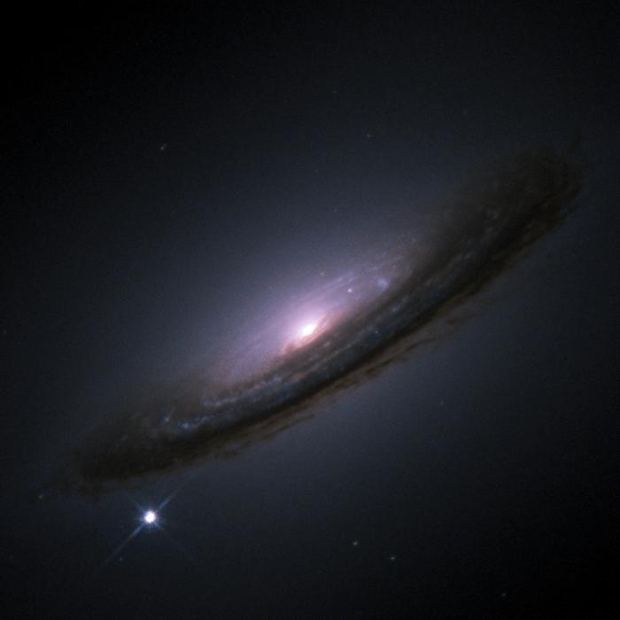
Image: Researchers used type Ia supernovae, similar to SN1994d pictured in its host galaxy NGC4526, to help establish that the universe’s expansion may actually have started to slow. Credit: NASA/ESA.
If this is the case, then the dimming of supernovae has to take into account not just cosmological effects but the somewhat more mundane astrophysics of the progenitor stars. Put that finding into the supernovae data showing universal expansion and a new model emerges, diverging from the widely accepted ΛCDM (Lambda Cold Dark Matter) cosmology, which offers a structure of dark energy, dark matter and normal matter. This work forces attention on a model derived from baryonic acoustic oscillations (BAO) and Cosmic Microwave Background data, which shows dark energy weakening significantly with time. From the paper:
…when the progenitor age-bias correction is applied to the SN data, not only does the future universe transition to a state of decelerated expansion, but the present universe also already shifts toward a state closer to deceleration rather than acceleration. Interestingly, this result is consistent with the prediction obtained when only the DESI BAO and CMB data are combined… Together with the DESI BAO result, which suggests that dark energy may no longer be a cosmological constant, our analysis raises the possibility that the present universe is no longer in a state of accelerated expansion. This provides a fundamentally new perspective that challenges the two central pillars of the CDM standard cosmological model proposed 27 yr ago.
Let’s pause a moment. DESI stands for the Dark Energy Spectroscopic Instrument, which is installed on the 4-meter telescope at Kitt Peak (Arizona). Here the effort is to measure the effects of dark energy by collecting, as the DESI site says, “optical spectra for tens of millions of galaxies and quasars, constructing a 3D map spanning the nearby universe to 11 billion light years.” Baryon acoustic oscillations are the ‘standard ruler’ that reflect early density fluctuations in the cosmos and hence chart the expansion at issue.
Here’s a comment from Young-Wook Lee:
“In the DESI project, the key results were obtained by combining uncorrected supernova data with baryonic acoustic oscillations measurements, leading to the conclusion that while the universe will decelerate in the future, it is still accelerating at present. By contrast, our analysis — which applies the age-bias correction — shows that the universe has already entered a decelerating phase today. Remarkably, this agrees with what is independently predicted from BAO-only or BAO+CMB analyses, though this fact has received little attention so far.”
Presumably it will receive more scrutiny now, with the team continuing its research through supernovae data from galaxies at various levels of redshift. That dark energy work is moving rapidly is reflected in the fact that the Vera Rubin Observatory is projected to discover on the order of 20,000 supernova host galaxies within the next five years, which will allow ever more precise measurements. Meanwhile, the evidence for dark energy as an evolving force continues to grow. Time will tell how robust the Korean team’s correction to what it calls ‘age bias’ in individual supernova readings really is.
The paper is Junhyuk Son et al., “Strong progenitor age bias in supernova cosmology – II. Alignment with DESI BAO and signs of a non-accelerating universe,” Monthly Notices of the Royal Astronomical Society, Volume 544, Issue 1, November 2025, pages 975–987 (full text).

Building an Interstellar Philosophy 5 Nov 5:36 AM (last month)
As the AI surge continues, it’s natural to speculate on the broader effects of machine intelligence on deep space missions. Will interstellar flight ever involve human crews? The question is reasonable given the difficulties in propulsion and, just as challenging, closed loop life support that missions lasting for decades or longer naturally invoke. The idea of starfaring as the province of silicon astronauts already made a lot of sense. Thinkers like Martin Rees, after all, think non-biological life is the most likely intelligence we’re likely to find.
But is this really an either/or proposition? Perhaps not. We can reach the Kuiper Belt right now, though we lack the ability to send human crews there and will for some time. But I see no contradiction in the belief that steadily advancing expertise in spacefaring will eventually find us incorporating highly autonomous tools whose discoveries will enable and nurture human-crewed missions. In this thought, robots and artificial intelligence invariably are first into any new terrain, but perhaps with their help one day humans do get to Proxima Centauri.
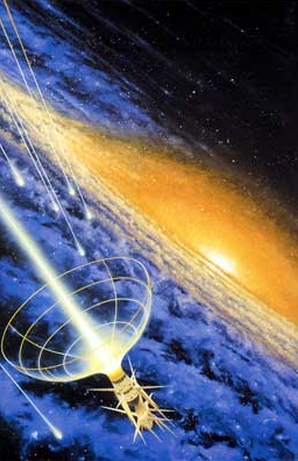
An interesting article in the online journal NOĒMA prompts these reflections. Robin Wordsworth is a professor of Environmental Science and Engineering as well as Earth and Planetary Sciences at Harvard. His musings invariably bring to mind a wonderful conversation I had with NASA’s Adrian Hooke about twenty years ago at the Jet Propulsion Laboratory. We had been talking about the ISS and its insatiable appetite for funding, with Hooke pointing out that for a fraction of what we were spending on the space station, we could be putting orbiters around each planet and some of their moons.
Image credit: Manchu.
It’s hard to argue with the numbers, as Wordsworth points out that the ISS has so far cost many times more than Hubble or the James Webb Space Telescope. It is, in fact, the most expensive object ever constructed by human beings, amounting thus far to something in the range of $150 billion (the final cost of ITER, by contrast, is projected at a modest $24 billion). Hooke, an aerospace engineer, was co-founder of the Consultative Committee for Space Data Systems (CCSDS) and was deeply involved in the Apollo project. He wasn’t worried about sending humans into deep space but simply about maximizing what we were getting out of the dollars we did spend. Wordsworth differs.
In fact, sketching the linkages between technologies and the rest of the biosphere is what his essay is about. He sees a human future in space as essential. His perspective moves backward and forward in time and probes human growth as elemental to space exploration. He puts it this way:
Extending life beyond Earth will transform it, just as surely as it did in the distant past when plants first emerged on land. Along the way, we will need to overcome many technical challenges and balance growth and development with fair use of resources and environmental stewardship. But done properly, this process will reframe the search for life elsewhere and give us a deeper understanding of how to protect our own planet.
That’s a perspective I’ve rarely encountered at this level of intensity. A transformation achieved because we go off planet that reflects something as fundamental as the emergence of plants on land? We’re entering the domain of 19th Century philosophy here. There is precedent in, for example, the Cosmism created by Nikolai Fyodorov in the 19th Century, which saw interstellar flight as a simple necessity that would allow human immortality. Konstantin Tsiolkovsky embraced these ideas but welded them into a theosophy that saw human control over nature as an almost divine right. As Wordsworth notes, here the emphasis was entirely on humans and not any broader biosphere (and some of Tsiolkovsky’s writings on what humans should do to nature are unsettling}.
But getting large numbers of humans off planet is proving a lot harder than the optimists and dreamers imagined. The contrast between Gerard O’Neill’s orbiting arcologies and the ISS is only one way to make the point. As we’ve discussed here at various times, human experiments with closed loop biological systems have been plagued with problems. Wordsworth points to the concept of the ‘ecological footprint,’ which makes estimates of how much land is required to sustain a given number of human beings. The numbers are daunting:
Per-person ecological footprints vary widely according to income level and culture, but typical values in industrialized countries range from 3 to 10 hectares, or about 4 to 14 soccer fields. This dwarfs the area available per astronaut on the International Space Station, which has roughly the same internal volume as a Boeing 747. Incidentally, the total global human ecological footprint, according to the nonprofit Global Footprint Network, was estimated in 2014 to be about 1.7 times the Earth’s entire surface area — a succinct reminder that our current relationship with the rest of the biosphere is not sustainable.
As I interpret this essay, I’m hearing optimism that these challenges can be surmounted. Indeed, the degree to which our Solar System offers natural resources is astonishing, both in terms of bulk materials as well as energy. The trick is to maintain the human population exploiting these resources, and here the machines are far ahead of us. We can think of this not simply as turning space over to machinery but rather learning through machinery what we need to do to make a human presence there possible in longer timeframes.
As for biological folk like ourselves, moving human-sustaining environments into space for long-term occupation seems a distinct possibility, at least in the Solar System and perhaps farther. Wordsworth comments:
…the eventual extension of the entire biosphere beyond Earth, rather than either just robots or humans surrounded by mechanical life-support systems, seems like the most interesting and inspiring future possibility. Initially, this could take the form of enclosed habitats capable of supporting closed-loop ecosystems, on the moon, Mars or water-rich asteroids, in the mold of Biosphere 2. Habitats would be manufactured industrially or grown organically from locally available materials. Over time, technological advances and adaptation, whether natural or guided, would allow the spread of life to an increasingly wide range of locations in the solar system.
Creating machines that are capable of interstellar flight from propulsion to research at the target and data return to Earth pushes all our limits. While Wordsworth doesn’t address travel between stars, he does point out that the simplest bacterium is capable of growth. Not so the mechanical tools we are so far capable of constructing. A von Neumann probe is a hypothetical constructor that can make copies of itself, but it is far beyond our capabilities. The distance between that bacterium and current technologies, as embodied for example in our Mars rovers, is vast. But machine evolution surely moves to regeneration and self-assembly, and ultimately to internally guided self-improvement. Such ‘descendants’ challenge all our preconceptions.
What I see developing from this in interstellar terms is the eventual production of a star-voyaging craft that is completely autonomous, carrying our ‘descendants’ in the form of machine intellects to begin humanity’s expansion beyond our system. Here the cultural snag is the lack of vicarious identification. A good novel lets you see things through human eyes, the various characters serving as proxies for yourself. Our capacity for empathizing with the artilects we send to the stars is severely tested because they would be non-biological. Thus part of the necessary evolution of the starship involves making our payloads as close to human as possible, because an exploring species wants a stake in the game it has chosen to play.
We will need machine crewmembers so advanced that we have learned to accept their kind as a new species, a non-biological offshoot of our own. We’re going to learn whether empathy with such beings is possible. A sea-change in how we perceive robotics is inevitable if we want to push this paradigm out beyond the Solar System. In that sense, interstellar flight will demand an extension of moral philosophy as much as a series of engineering breakthroughs.
The October 27 issue of The New Yorker contains Adam Kirsch’s review of a new book on Immanuel Kant by Marcus Willaschek, considered a leading expert on Kant’s era and philosophy. Kant believed that humans were the only animals capable of free thought and hence free will. Kirsch adds this:
…the advance of A.I. technology may soon put an end to our species’ monopoly on mind. If computers can think, does that mean that they are also free moral agents, worthy of dignity and rights? Or does it mean, on the contrary, that human minds were never as free as Kant believed—that we are just biological machines that flatter ourselves by thinking we are something more? And if fundamental features of the world like time and space are creations of the human mind, as Kant argued, could artificial minds inhabit entirely different realities, built on different principles, that we will never fully understand?
My thought is that if Wordsworth is right that we are seeing a kind of co-evolution at work – human and machine evolution accelerated by expansion into this new environment – then our relationship with the silicon beings we need will demand acceptance of the fact that consciousness may never be fully measured. We have yet to arrive at an accepted understanding of what consciousness is. Most people I talk to see that as a barrier. I’m going to see it as a challenge, because our natures make us explorers. And if we’re going to continue the explorations that seem part of our DNA, we’re now facing a frontier that’s going to demand consensual work with beings we create.
Will we ever know if they are truly conscious? I don’t think it matters. If I’m right, we’re pushing moral philosophy deeply into the realm of the non-biological. The philosophical challenge is immense, and generative.
The article is Wordsworth, “The Future of Space is More Than Human,” in the online journal NOĒMA, published by the Berggruen Institute and available here.

Jupiter’s Impact on the Habitable Zone 29 Oct 10:34 AM (last month)
I’ve been thinking about how useful objects in our own Solar System are when we compare them to other stellar systems. Our situation has its idiosyncrasies and certainly does not represent a standard way for planetary systems to form. But we can learn a lot about what is happening at places like Beta Pictoris by studying what we can work out about the Sun’s protoplanetary disk and the factors that shaped it. Illumination can come about in both directions.
Think about that famous Voyager photograph of Earth, now the subject of an interesting new book by Jon Willis called The Pale Blue Data Point (Princeton, 2025). I’m working on this one and am not yet ready to review it, but when I do I’ll surely be discussing how the best we can do at studying a living terrestrial planet at a considerable distance is our own planet from 6 billion kilometers. We’ll use studies of the pale blue dot to inform our work with new instrumentation as we begin to resolve planets of the terrestrial kind.
But let’s look much further out, and a great deal further back in time. A 2003 detection at Beta Pictoris led eventually to confirmation of a planet in the early stages of formation there. Probing how exoplanets form is an ongoing task stuffed with questions and sparkling with new observations. As with every other aspect of exoplanet research, things are moving quickly in this area. Perhaps 25 million years old, this system offers information about the mechanisms involved in the early days of our own. Here on Earth, we also get the benefit of meteorites delivering ancient material for our inspection.
The role of Jupiter in shaping the protoplanetary disk is hard to miss. We’re beginning to learn that planetesimals, which are considered the building blocks of planets, did not form simultaneously around the Sun, and the mechanisms now coming into view affect any budding planetary system. In new work out of Rice University, senior author André Izidoro and graduate student Baibhav Srivastava have gone to work on dust evolution and planet formation using computer simulations that analyze the isotopic variation among meteorites as clues to a process that may be partially preserved in carbonaceous chondrites.
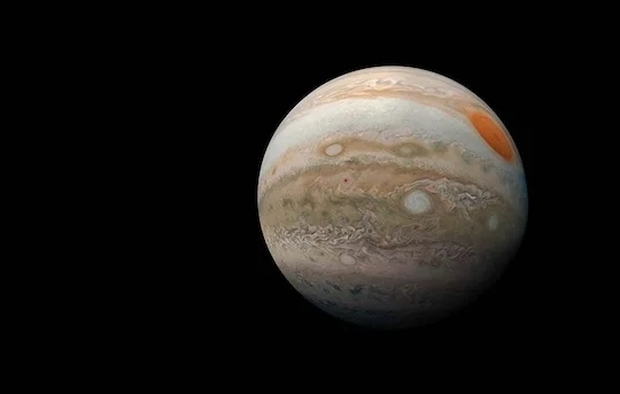
Image: Enhanced image of Jupiter by Kevin M. Gill (CC-BY) based on images provided courtesy of NASA/JPL-Caltech/SwRI/MSSS (Credit: NASA).
The authors posit that dense bands of planetesimals, created by the gravitational effects of the early-forming Jupiter, were but the second generation of such objects in the system’s history. The earlier generation, whose survivors are noncarbonaceous (NC) magmatic iron meteorites, seems to have formed within the first million years. Some two to three million years would pass before the chondrites formed, containing within themselves calcium-aluminum–rich inclusions from that earlier time. The rounded grains called ‘chrondules’ contain once molten silicates that help to preserve that era.
The key fact: Meteorites from objects that formed during the first generation of planetesimal formation melted and differentiated, making retrieval of their original composition problematic. Chondrites, which formed later, better preserve dust from the early Solar System and also contain distinctive ‘chondrules,’ which solidified after going through an early molten state. But the very presence of this isotopic variation demands explanation. From the paper:
…the late accretion of a planetesimal population does not appear readily compatible with a key feature of the Solar System: its isotopic dichotomy. This dichotomy—between NC and carbonaceous (CC) meteorites —is typically attributed to an early and persistent separation between inner and outer disk reservoirs, established by the formation of Jupiter or a pressure bump. In this framework, Jupiter (or a pressure bump) acts as a barrier that prevents the inward drift of pebbles from the outer disk and mixing, preserving isotopic distinctiveness.
But this ‘barrier’ would also seem to prevent small solids moving inwards to the inner disk, so the question becomes, how did enough material remain to allow the formation of early planetesimals at the later era of the chondrites? What is needed is a way to ‘re-stock’ this reservoir of material. Hence this paper. The authors hypothesize a ‘replenished reservoir’ of inner disk materials gravitationally gathered in the gaps in the disk opened up by Jupiter. The accretion of the chondrites and the locations where the terrestrial planets formed are interconnected as the early disk is shaped by the gas giant.
André Izidoro (Rice University) is senior author of the paper:
“Chondrites are like time capsules from the dawn of the solar system. They have fallen to Earth over billions of years, where scientists collect and study them to unlock clues about our cosmic origins. The mystery has always been: Why did some of these meteorites form so late, 2 to 3 million years after the first solids? Our results show that Jupiter itself created the conditions for their delayed birth.”
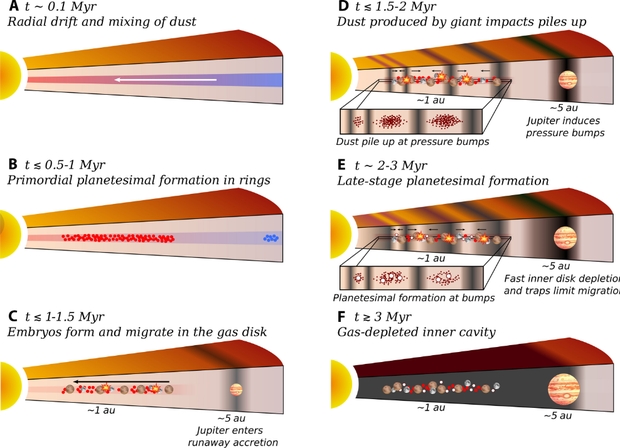
Image: This is Figure 1 from the paper. Caption: Schematic illustration of the proposed evolutionary scenario for the early inner Solar System over the first ~3 Myr. (A) At early times (t ~ 0.1 Myr), radial drift and turbulent mixing transport dust grains across the disk. (B) Around ≲ 0.t to 1 Myr, primordial planetesimal formation occurs in rings. (C) By ~1.5 Myr, growing planetary embryos start to migrate inward under the influence of the gaseous protoplanetary disk, whereas Jupiter’s core enters rapid gas accretion phase. (D) Around ~2 Myr, Jupiter’s gravitational perturbations excite spiral density waves, inducing pressure bumps in the inner disk. Giant impacts among migrating embryos generate additional debris. Pressure bumps act as dust traps, halting inward drift of small solids and leading to dust accumulation. (E) Between ~2 and 3 Myr, dust accumulation at pressure bumps leads to the formation of a second generation of planetesimals. Rapid gas depletion in the inner disk, combined with the presence of these traps, limits the inward migration of growing embryos. (F) By ~3 Myr, the inner gas disk is largely dissipated, resulting in a system composed of terrestrial embryos and a second generation of planetesimals—potentially the parent bodies of ordinary and enstatite chondrites—whereas the inner disk evolves into a gas-depleted cavity.
A separation between material from the outer Solar System and the inner regions preserved the distinctive isotopic signatures in the two populations. Opening up this gap, according to the authors, enabled regions where new planetesimals could grow into rocky worlds. Meanwhile, the presence of the gas giant also prevented the flow of gaseous materials toward the inner system, suppressing what might have been migration of young planets like ours toward the Sun. These are helpful simulations in that they sketch a way for planetesimals to form without being drawn into our star, but there are broad issues that remain unanswered here, as the paper acknowledges:
Our simulations demonstrate that Jupiter’s induced rapid inner gaseous disk depletion, gaps, and rings are broadly consistent with both the birthplaces of the terrestrial planets and the accretion ages of the parent bodies of NC chondrites. Our results suggest that Jupiter formed early, within ~1.5 to 2 Myr of the Solar System’s onset, and strongly influenced the inner disk evolution….
And here is reason for caution:
…we…neglect the effects of Jupiter’s gas-driven migration. This simplification is motivated by the fact that, once Jupiter opens a deep gap in a low-viscosity disk, its migration is expected to be fairly slow, particularly as the inner disk becomes depleted. Simulations show that, in low-viscosity disks, migration can be halted or reversed depending on the local disk structure. In reality, Jupiter probably formed beyond the initial position assumed in our simulations and first migrated via type I migration and eventually entered in the type II regime… but its exact migration history is difficult to constrain.
The authors thus guide the direction of future research into further consideration of Jupiter’s migration and its effects upon disk dynamics. Continuing study of young disks like that afforded by the Atacama Large Millimeter/submillimeter Array (ALMA) and other telescopes will help to clarify the ways in which disks can spawn first gas giants and then rocky worlds.
The paper is Srivastava & Izidoro, “The late formation of chondrites as a consequence of Jupiter-induced gaps and rings,” Science Advances Vol. 11, No. 43 (22 October 2025). Full text.

Interstellar Mission to a Black Hole 23 Oct 6:10 AM (last month)
We normally think of interstellar flight in terms of reaching a single target. The usual destination is one of the Alpha Centauri stars, and because we know of a terrestrial-mass planet there, Proxima Centauri emerges as the best candidate. I don’t recall Proxima ever being named as the destination Breakthrough Starshot officially had in mind, but there is such a distance between it (4.2 light years) and the next target, Barnard’s Star at some 5.96 light years, that it seems evident we will give the nod to Proxima. If, that is, we decide to go interstellar.
Let’s not forget, though, that if we build a beaming infrastructure either on Earth or in space that can accelerate a sail to a significant percentage of lightspeed, we can use it again and again. That means many possible targets. I like the idea of exploring other possibilities, which is why Cosimo Bambi’s ideas on black holes interest me. Associated with Fudan University in Shanghai as well as New Uzbekistan University in Tashkent, Bambi has been thinking about the proliferation of black holes in the galaxy, and the nearest one to us. I’ve been pondering his notions ever since reading about them last August.
Black holes are obviously hard to find as we scale down to solar mass objects, and right now the closest one to us is GAIA-BH1, some 1560 light years out. But reading Bambi’s most recent paper, I see that one estimate of the number of stellar mass black holes in our galaxy is 1.4 X 109. Bambi uses this number, but as we might expect, estimates vary widely, from 10 million to 1 billion. These numbers are extrapolated from the population of massive stars and to a very limited extent on clues from observational astronomy.
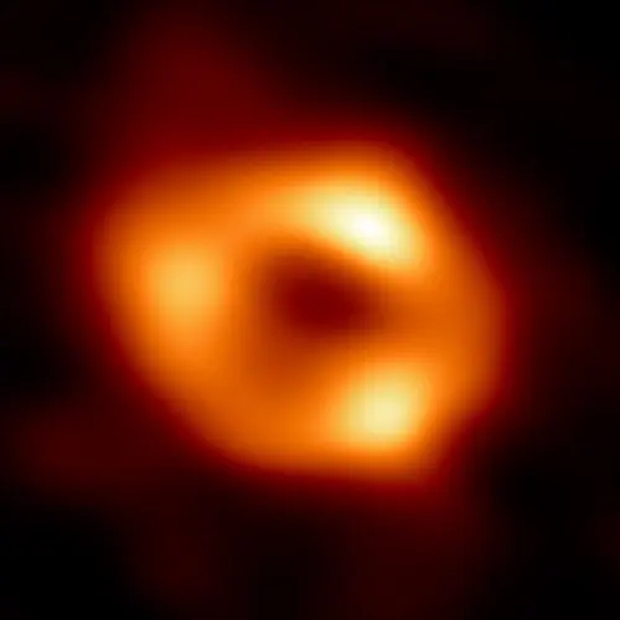
Image: The first image of Sagittarius A*, or Sgr A*, the supermassive black hole at the center of our galaxy. Given how hard it was to achieve this image, can we find ways to locate far smaller solar-mass black holes, and possibly send a mission to one? Credit: Event Horizon Telescope Collaboration.
Bambi calculates a population of 1 black hole and 10 white dwarfs for every 100 stars in the general population. If he’s anywhere close to right, a black hole might well exist within 20 to 25 light years, conceivably detected in future observations by its effects upon the orbital motion of a companion star, assuming we are so lucky as to find a black hole in a binary system. The aforementioned GAIA-BH1 is in such a system, orbiting a companion star.
Most black holes, though, are thought to be isolated. One black hole (OGLE-2011-BLG-0462) has been detected through microlensing, and perhaps LIGO A+, the upgrade to the two LIGO facilities in Hanford, Washington, and Livingston, Louisiana, can help us find more as we increase our skills at detecting gravitational waves. There are other options as well, as Bambi notes:
Murchikova & Sahu (2025) proposed to use observational facilities like the Square Kilometer Array (SKA), the Atacama Large Millimiter/Submillimiter Array (ALMA), and James Webb Space Telescope (JWST). Isolated black holes moving through the interstellar medium can accrete from the interstellar medium itself and such an accretion process produces electromagnetic radiation. Murchikova & Sahu (2025) showed that current observational facilities can already detect the radiation from isolated black holes in the warm medium of the Local Interstellar Cloud within 50 pc of Earth, but their identification as accreting black holes is challenging and requires multi-telescope observations.
If we do find a black hole out there at, say, 10 light years, we now have a target for future beamed sailcraft that offers an entirely different mission concept. We’re now probing not simply an unknown planet, but an astrophysical object so bizarre that observing its effects on spacetime will be a primary task. Sending two nanocraft, one could observe the other as it approaches the black hole. A signal sent from one to the other will be affected by the spacetime metric – the ‘geometry’ of spacetime – which would give us information about the Kerr solution to the phenomenon. The latter assumes a rotating black hole, whereas other solutions, like that of Schwarzschild, describe a non-rotating black hole.
Also intriguing is Bambi’s notion of testing fundamental constants. Does atomic physics change in gravitational fields this strong? There have been some papers exploring possible variations in fundamental constants over time, but little by way of observation studying gravitational fields much stronger than white dwarf surfaces. Two nanocraft in the vicinity of a black hole may offer a way to emit photons whose energies can probe the nature of the fine structure constant. The latter sets the interactions between elementary charged particles.
For that matter, is a black hole inevitably possessed of an event horizon, or is it best described as an ‘horizonless compact object’ (Bambi’s term)?
In the presence of an event horizon, the signal from nanocraft B should be more and more redshifted (formally without disappearing, as an observer should never see a test-particle crossing the event horizon in a finite time, but, in practice, at some point the signal leaves the sensitivity band of the receiver on nanocraft A). If the compact object is a Kerr black hole, we can make clear predictions on the temporal evolution of the signal emitted by nanocraft B. If the compact object is a fuzzball [a bound state without event horizon], the temporal evolution of the signal should be different and presumably stop instantly when nanocraft B is converted into fuzzball degrees of freedom.
There are so many things to learn about black holes that it is difficult to know where to begin, and I suspect that if many of our space probes have returned surprising results (think of the remarkable ‘heart’ on Pluto), a mission to a black hole would uncover mysteries and pose questions we have yet to ask. What an intriguing idea, and to my knowledge, no one else has made the point that if we ever reach the level of launching a mission to Proxima Centauri, we should be capable of engineering the same sort of flyby of a nearby black hole.
And on the matter of small black holes, be aware of a just released paper examining the role of dark matter in their formation. This one considers black holes on a much smaller scale, possibly making the chances of finding a nearby one that much greater. Let me quote the abstract (the italics are mine). The citation is below:
Exoplanets, with their large volumes and low temperatures, are ideal celestial detectors for probing dark matter (DM) interactions. DM particles can lose energy through scattering with the planetary interior and become gravitationally captured if their interaction with the visible sector is sufficiently strong. In the absence of annihilation, the captured DM thermalizes and accumulates at the planet’s center, eventually collapsing into black holes (BHs). Using gaseous exoplanets as an example, we demonstrate that BH formation can occur within an observable timescale for superheavy DM with masses greater than 106 GeV and nuclear scattering cross sections. The BHs may either accrete the planetary medium or evaporate via Hawking radiation, depending on the mass of the DM that formed them. We explore the possibility of periodic BH formation within the unconstrained DM parameter space and discuss potential detection methods, including observations of planetary-mass objects, pulsed high-energy cosmic rays, and variations in exoplanet temperatures. Our findings suggest that future extensive exoplanet observations could provide complementary opportunities to terrestrial and cosmological searches for superheavy DM.
The paper is Bambi, “An interstellar mission to test astrophysical black holes,” iScience Volume 28, Issue 8113142 (August 15, 2025). Full text. The paper on black holes and dark matter is Phoroutan-Mehr & Fetherolf, “Probing superheavy dark matter with exoplanets,” Physical Review D Vol. 112 (20 August 2025), 036012 (full text).

Teegarden’s Star b: A Habitable Red Dwarf Planet? 18 Oct 6:34 AM (last month)
I have a number of things to say about Teegarden’s Star and its three interesting planets, but I want to start with the discovery of the star itself.
Here we have a case of a star just 0.08 percent as massive as the Sun, an object which is all but in brown dwarf range and thus housing temperatures low enough to explain why, despite its proximity, it took until 2003 to find it.
Moreover, conventional telescopes were not the tools of discovery but archival data. Bonnard Teegarden (NASA GSFC) dug into archival data from the Near-Earth Asteroid Tracking program, surmising that there ought to be more small stars near us than we were currently seeing. The data mining paid off, and then paid off again when the team looked at the Palomar Sky Survey of 1951. This was a team working without professional astronomers and telescopes.
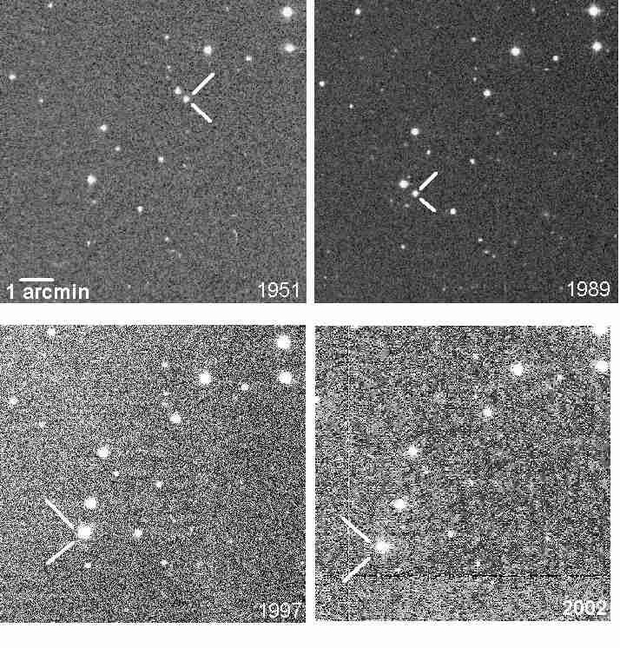
Image: Teegarden’s Star was subsequently identified in astronomical images taken more than 50 years ago. Credit: Palomar Sky Survey / SolStation.com.
That it took until 2019 to announce evidence of planets reflects the fact that for some time, we had trouble even coming up with a workable parallax reading, one that finally produced a distance of 12.497 light years. There are no transits at Teegarden’s Star, so the discovery data on the first two planets came through radial velocity studies conducted with the CARMENES instrument at the Calar Alto Observatory in Spain. In 2024 a third planet was found, likewise by RV.
Teegarden’s Star compels attention because of those planets, and in particular Teegarden’s Star b, which orbits just inside the habitable zone with an orbit lasting about five days. Its minimum mass, calculated from the radial velocity data, is 1.05 times that of Earth, but recall that because of the limitations of the RV method, we can’t know the orbital inclination of a world that is likely larger. The primary is relatively quiescent by red dwarf standards, and indeed produces flares that would not be problematic if planet b retained an atmosphere.
That last note is important, because the whole question of how long the planets of young red dwarfs retain an atmosphere is crucial. Teegarden’s Star is about eight billion years old and, as I mention, comparatively calm. But young red dwarfs can spit out enormous flares and present serious problems for atmospheric gases, to the point that the atmospheres may be depleted or destroyed altogether. We need to come to grips with the possibility that red dwarfs may simply be inhospitable to life, a notion skillfully dissected by David Kipping in a recent paper that I plan to address in the near future.
For now, though, let’s take a brief look at a new paper from Ryan Boukrouche and Rodrigo Caballero (Stockholm University) and Neil Lewis (University of Exeter). The authors tackle climate and potential habitability of Teegarden’s Star b, noting that its proximity puts it in the catalog for study by next-generation observatories. The team uses a three-dimentional global climate model (GCM) to study habitability, including position in the habitable zone and the question of surface climate if there is an Earth-like atmosphere.
The interest in Teegarden’s Star draws not only from its Earth-mass planets – which Boukrouche and colleagues see as prime fodder for future telescopes like the ESO’s Extremely Large Telescope and its Planetary Camera and Spectrograph – but the effect of flare activity on atmospheres. The authors assume that Teegarden’s Star b is tidally locked given its tight orbit (4.9 days) around the primary. They consider values for surface albedo which approximate first an ocean-dominated surface and then a surface dominated by land masses. Here the discussion reaches this conclusion: “Although the sensitivity to surface albedo is… relatively small, it illustrates that the habitable zone does depend on factors intrinsic to the planet, not just on orbital parameters.”
The results indicate that this intriguing planet may be habitable under these atmosphere assumptions, but if so, it is still close to the inner edge of the habitable zone. Indeed, of two different orbital distances chosen from earlier papers investigating this planet, one produces a runaway greenhouse effect that would prevent the presence of liquid water on the surface. Fittingly, the authors are sensitive to the fact that the habitability question hinges upon the configuration of their models. Citing studies of TRAPPIST-1, they note this:
…different GCMs configured to simulate the same planet can produce a range of climates and circulation regimes (presumably owing to differences between the parameterizations included in each model). For example, models capable of consistently simulating non-dilute atmospheres may explore the possibility that under a range of instellation values, the planet’s atmosphere might be in a moist greenhouse state (Kasting et al. 1984) instead of a runaway, where water builds up enough that the stratosphere becomes moist, driving photodissociation and loss of water to space.
Installation is critical. The classic problem: We need more data, which can only be supplied by future telescopes. Teegarden’s Star remains highly interesting, but if we have yet to nail down the orbital distance of a planet so close to the inner edge of the habitable zone, we can’t yet make the call on how much light and heat this planet receives. And the authors themselves point out that the origins of nitrogen on Earth are not completely understood, which makes guesses at its abundance in other worlds’ atmospheres problematic.
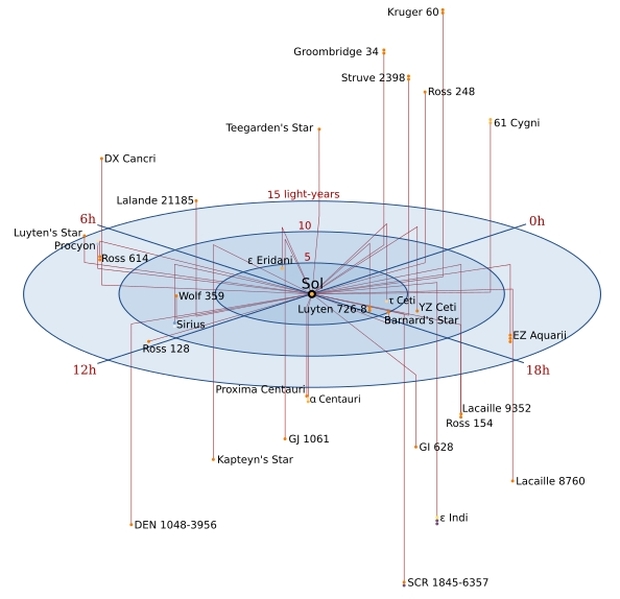
Image: Even in our local ‘neighborhood,’ the data on Earth-mass planets is paltry, and our investigations rely heavily on simulations with values plugged in to gauge the possibilities. New instrumentation will help but it’s sobering to realize how far we are from making the definitive call on such basic issues as whether a given rocky world even has an atmosphere. Image credit: Inductiveload – self-made, Mathematica, Inkscape. Via Wikimedia Commons.
Let me just suggest that this is where we are right now when it comes to key questions about life around nearby stars. Plugging in the necessary data on any system takes time and, when it comes to Earth-mass planets around red dwarfs, the kind of instrumentation that is still on the drawing boards or in some cases under construction. Given all that, we’re going to have quite a few years ahead of us in which we’re constructing theories to explain what we see without the solid data that will help us choose among myriad alternatives.
The paper is Boukrouche, Caballero & Lewis, “Near the Runaway: The Climate and Habitability of Teegarden’s Star b,” accepted at The Astrophysical Journal Letters. Preprint available.

A Dark Object or ‘Dark Matter’? 14 Oct 9:29 AM (last month)
We are fortunate enough to be living in the greatest era of discovery in the history of our species. Astronomical observations through ever more sensitive instruments are deepening our view of the cosmos, and just as satisfyingly, forcing questions about its past and uncertain future. I’d much rather live in a universe with puzzling signs of accelerated expansion (still subject to robust debate) and evidence of matter that does not interact with the electromagnetic force (dark matter) than in one I could completely explain.
Thus the sheer enjoyment of mystery, a delight accented this morning as I contemplate the detection of a so-called ‘dark object’ of unusually low mass. Presented in both Nature Astronomy and Monthly Notices of the Royal Astronomical Society, the papers describe an object that could only be detected through gravitational lensing, a familiar exoplanet detection tool that reshapes light passing near it. With proper analysis, the nature of the distortion can produce a solid estimate of the amount of matter involved.
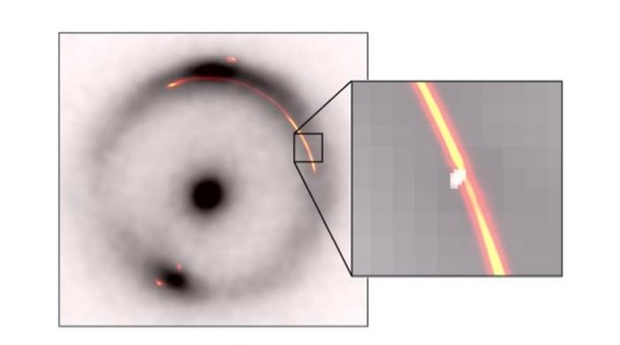
Image: The black ring and central dot show an infrared image of a distant galaxy distorted by a gravitation lens. Orange/red shows radio waves from the same object. The inset shows a pinch caused by another, much smaller, dark gravitational lens (white blob). Credit: Devon Powell, Max Planck Institute for Astrophysics.
We wouldn’t have any notion of dark matter were it not for the fact that while we cannot see it via photons, it does interact with gravity, and was indeed first hypothesized because of the anomalous rotation of distant galaxies. Fritz Zwicky was making conjectures about the Coma Cluster of galaxies way back in the 1930s, while Jan Oort pondered mass and observed motion of the Milky Way’s stars in the same period. It would be Vera Rubin in the 1970s who reawakened the study of dark matter, with her observations of stellar rotation around galactic centers, which proved to be too fast to be explained without additional mass, meaning mass that we currently couldn’t see.
The present work involves the Green Bank Telescope in West Virginia, the Very Long Baseline Array in Hawaii and the European Very Long Baseline Interferometric Network, which creates a virtual telescope the size of Earth. Heavy-hitter instrumentation for sure, and all of it necessary to spot the infinitesimal signals of the gravitational lensing created by this object.
Devon Powell (Max Planck Institute for Astrophysics, Germany is lead author of the paper in Nature Astronomy:
“Given the sensitivity of our data, we were expecting to find at least one dark object, so our discovery is consistent with the so-called ‘cold dark matter theory’ on which much of our understanding of how galaxies form is based. Having found one, the question now is whether we can find more and whether the numbers will still agree with the models.”
An interesting question indeed. It raises the question of whether dark matter can exist in regions without any stars, and offers at least a tentative answer. Or will we subsequently learn that this object is something a bit more prosaic, a compact and inactive dwarf galaxy from the very early universe? The authors point out that this is the lowest mass object ever found through gravitational lensing, which points to the likelihood that future searches will uncover other examples. We’re clearly at the beginning of the study of dark matter and remain ignorant of its makeup, so we can expect this work to continue. New lens-modeling techniques and datasets taken at high angular resolution provide the tools needed to make images more detailed than any before taken of the high-redshift universe and gravitationally lensed objects.
From the Powell et al. paper:
Strong gravitational lensing offers a powerful alternative pathway for studying low-mass objects with little to no EM luminosity. A spatially extended source in a galaxy-scale strong lens system acts as a backlight for the gravitational landscape of its lens galaxy, revealing low-mass perturbers through their gravitational effects alone. Furthermore, lens galaxies typically lie in the redshift range 0.2 ≲ z ≲ 1.5, which means that low-mass, low-luminosity objects can be detected and studied across cosmic time. To date, observations of galaxy-scale lenses with resolved arcs have been used to detect three low-mass perturbers: discovered by Hubble, Keck and ALMA…[E]xpanding the mass range that we can robustly probe necessitates that we use strong lens observations at the highest possible angular resolution.
The first paper is Powell et al., “A million-solar-mass object detected at a cosmological distance using gravitational imaging,” Nature Astronomy 4 March 2025. Full text. The second paper is McKean et al., “An extended and extremely thin gravitational arc from a lensed compact symmetric object at redshift of 2.059.” Monthly Notices of the Royal Astronomical Society Vol. 544, Issue 1 (November, 2025), L24-30. Full text.

Solar Sails for Space Weather 9 Oct 5:34 AM (2 months ago)
A new paper dealing with solar phenomena catches my eye this morning. Based on work performed at the University of Michigan, it applies computer modeling to delve into what we can call ‘structures’ in the solar wind, which basically means large-scale phenomena like coronal mass ejections (CMEs) and powerful magnetic flux ‘ropes’ that are spawned by the interaction of a CME and solar wind plasma. What particularly intrigues me is a mission concept that the authors put to work here, creating virtual probes to show how our questions about these structures can be resolved if the mission is eventually funded.
More on that paper in a minute, but first let me dig into the mission’s background. It has been dubbed Space Weather Investigation Frontier, or SWIFT. Originally proposed in 2023 in Frontiers in Astronomy and Space Sciences and with a follow-up in 2025 in Acta Astronautica (citations below), the mission is the work of Mojtaba Akhavan-Tafti and collaborators at the University of Michigan, Les Johnson (NASA MSFC) and Adam Szabo (NASA GSFC). The latter is a co-author on today’s paper., which studies the use of the SWIFT probes to study large-scale solar activity.
What SWIFT would offer is the ability to monitor solar activity at a new level of detail through multiple space weather stations. A solar sail is crucial to the concept, for one payload must be placed closer to the Sun than the L1 Lagrange point, where gravitational equilibrium keeps a satellite in a fixed position relative to Sun and Earth. Operating closer to the Sun than L1 requires a solar sail that can exactly balance the momentum of solar photons and the gravitational force pulling it inward. If this ‘statite’ idea sounds familiar, it’s because the work grows out of NASA’s Solar Cruiser sail, a quadrant of which was successfully deployed last year on Earth. We’ve discussed Solar Cruiser in relation to the study of the Sun’s high latitudes using non-Keplerian orbits.
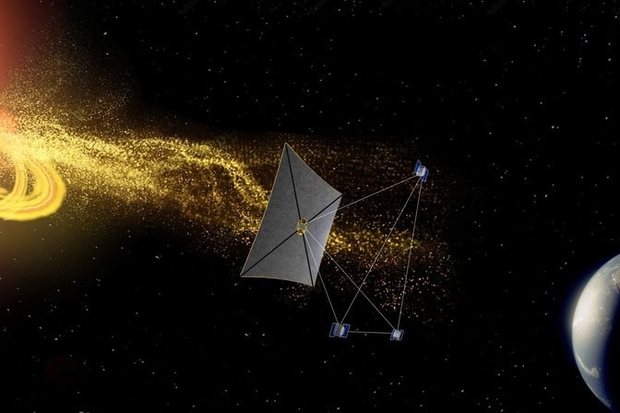
Image: An artist’s rendering of the spacecraft in the SWIFT constellation stationed in a triangular pyramid formation between the sun and Earth. A solar sail allows the spacecraft at the pyramid’s tip to hold station beyond L1 without conventional fuel. Credit: Steve Alvey, University of Michigan.
The SWIFT mission, unlike Solar Cruiser, would consist of four satellites – one of them using a large sail, and the other three equipped for chemical propulsion. Think of a triangular pyramid, with the sail-equipped probe at the top and the other three probes at each corner of the base in a plane around L1. Most satellites tracking Solar activity are either in low-Earth orbit or geosynchronous orbit, while current assets at the L1 point (WIND, ACE, DSCOVR, and IMAP) can offer up to 40 minutes of advance warning for dangerous solar events.
SWIFT would buy us more time, which could be used to raise satellite orbits that would be compromised by the increased drag caused by atmospheric heating during a geomagnetic storm. Astronauts likewise would receive earlier warning to take cover. But the benefits of this mission design go beyond small increases in alert time. With an approximate separation of up to 1 solar radius, the SWIFT probes would be able to extract data from four distinct vantage points.
Designed to fit the parameters of a Medium-Class Explorer mission, SWIFT is described in the Johnson et al. paper in Acta Astronautica as a ‘hub’ spacecraft (sail-equipped) with three ‘node’ spacecraft, all to be launched aboard a Falcon 9. The craft will fly “in an optimized tetrahedron constellation, covering scales between 10 and 100s of Earth radii.” A bit more from the paper:
This viewing geometry will enable scientists to distinguish between local and global processes driving space weather by revealing the spatial characteristics, temporal evolution, and geo-effectiveness of small-to meso-scale solar wind structures and substructures of macro-scale structures, such as interplanetary coronal mass ejections (ICMEs) and stream interaction regions (SIRs). In addition, real time measurements of earth-bound heliospheric structures from sub-L1 will improve our current forecasting lead-times by up to 35 percent.
Looking now at the paper “High-resolution Simulation of Coronal Mass Ejection–Corotating Interaction Region Interactions: Mesoscale Solar Wind Structure Formation Observable by the SWIFT Constellation,” with lead author W. B. Manchester, the scale of the potential SWIFT contribution becomes clear::
The radial and longitudinal spacecraft separations afforded by the SWIFT constellation enable analyses of the magnetic coherence and dynamics of meso- to large-scale solar wind structures… The main advantage of the tetrahedral constellation is its ability to distinguish between a structure’s spatial and temporal variations, as well as their orientations.
Coronal mass ejections are huge outbursts of plasma whose injections into the solar wind form mesoscale structures with profound implications for Earth. Magnetic field interactions can produce geomagnetic storms that play havoc with communications and navigation systems. The effects show up in unusual places. Sudden changes in Earth’s atmosphere can affect satellite orbits. On the ground, this particular study, out of the University of Michigan, cites a 2024 geomagnetic event that created large financial losses in agricultural areas in the US Midwest by crippling navigation systems on farm-belt tractors.
Mojtaba Akhavan-Tafti, co-author of the paper, notes the need for more precise detection of this phenomenon:
“If there are hazards forming out in space between the sun and Earth, we can’t just look at the sun. This is a matter of national security. We need to proactively find structures like these Earth-bound flux ropes and predict what they will look like at Earth to make reliable space weather warnings for electric grid planners, airline dispatchers and farmers.”
Flux ropes, between 3,000 and 6 million miles wide, are hard to recreate in current CME simulations and prove too large for existing modeling of magnetic field interactions with plasma. The new study produces a simulation that probes the phenomenon, showing that these ‘ropes’ are produced as the coronal mass ejection moves outward through solar wind plasma, and can form vortices interacting with different streams of solar wind. The authors compare them to tornadoes, noting that existing space weather-monitoring spacecraft are not always able to detect their formation. SWIFT will be able to spot them.
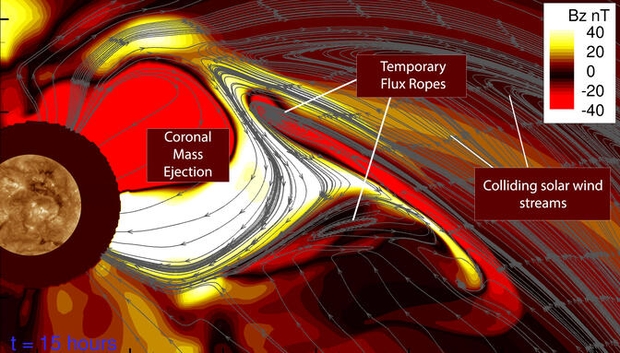
Image: A computer-generated image shows where rotating magnetic fields form at the edges of a coronal mass ejection 15 hours after a solar eruption. The coronal mass ejection is the large bubble extending from the sun at the left edge of the image. Two streams of plasma extend from the edge of the coronal mass ejection as it hits neighboring streams of fast and slow solar wind. Shades of red and yellow depict the strength and orientation of the plasma’s magnetic field (labeled “Bz” in the figure legend). Shades of red represent plasma that could trigger geomagnetic storms if it hits Earth, while shades of yellow represent plasma with a strong, positive orientation. The red-brown circle around the sun shows the area not covered by the simulation, about ten million miles wide. ILLUSTRATION: Chip Manchester, University of Michigan.
This is fascinating research into a topic with near-term ramifications, a matter of planetary defense that we can take steps to resolve soon, although as always we await funding decisions. In the larger perspective, here is another way sails can be employed for purposes no other propulsion method could achieve. Future sails could use these methods to ‘hover’ over the Sun’s polar regions. Moreover, close observation of space weather changes near the Earth has much to tell us about future mission concepts that would harness solar wind plasma to drive a magsail or enable an electric sail to reach high velocities.
The 2023 paper on SWIFT is Akhavan-Tafti et al., “Space weather investigation Frontier (SWIFT),” Frontiers in Astronomy and Space Sciences Vol 10 (2023), 1185603 (abstract). The 2025 paper is Johnson et al., “Space Weather Investigation Frontier (SWIFT) mission concept: Continuous, distributed observations of heliospheric structures from the vantage points of Sun-Earth L1 and sub-L1,” Acta Astronautica Vol. 236 (November 2025), 684=691 (abstract). The paper on solar activity as a target for SWIFT is Manchester et al., “High-resolution simulation of CME-CIR interactions: small- to mesoscale solar wind structure formation observable by the SWIFT constellation,” The Astrophysical Journal Vol. 992 No. 1 (2025), 51 (full text).

Rogue Planets: A Stellar Infancy? 2 Oct 6:03 AM (2 months ago)
How exoplanets emerge from circumstellar disks has always intrigued me, and many open questions remain, including the precise mechanisms behind the fast growth of gas giants. When the topic swings to so-called ‘rogue’ planets, formation issues seem to be the same, since we’ve assumed most such worlds have been ejected from a host system through gravitational interactions. But is there another formation path? We are learning that rogue planets are capable of feats not seen in conventional star/planet systems.
Research out of the National Institute for Astrophysics (INAF) in Italy is provocative. Using data from the European Southern Observatory’s Very Large Telescope (VLT) as well as the James Webb Space Telescope, Víctor Almendros-Abad (Astronomical Observatory of Palermo) and an international team of astronomers have found a large rogue planet (five to ten times as massive as Jupiter) that continues to form, accreting gas and dust from a surrounding cloud. No circumstellar disk required here. Growth comes in waves, now about eight times faster than just a few months before. We’re talking about accreting six billion tonnes per second, and a growth phenomenon hitherto restricted to young stars not yet on the Main Sequence.
Given this, we might consider Almendros-Abad’s comment an understatement:
“People may think of planets as quiet and stable worlds, but with this discovery we see that planetary-mass objects freely floating in space can be exciting places.”
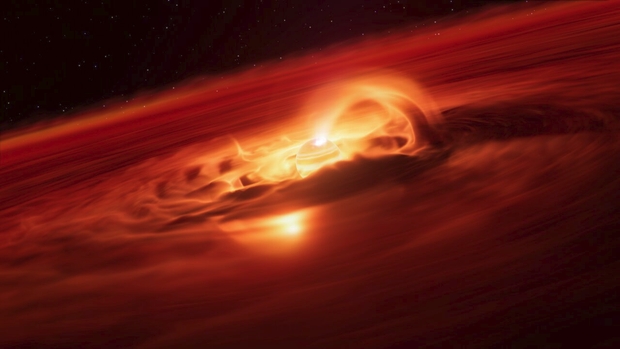
Image: Astronomers have identified an enormous ‘growth spurt’ in a so-called rogue planet. Unlike the planets in our Solar System, these objects do not orbit stars, free-floating on their own instead. The new observations, made with the European Southern Observatory’s Very Large Telescope (ESO’s VLT), reveal that this free-floating planet is eating up gas and dust from its surroundings at a rate of six billion tonnes a second. This is the strongest growth rate ever recorded for a rogue planet, or a planet of any kind, providing valuable insights into how they form and grow. Credit: ESO.
The rogue planet in question is dubbed Cha 1107-7626, some 620 light years out in the direction of the constellation Chamaeleon. This is one of those deep southern sky constellations announced in the early 17th Century by Dutch navigators. How they ever found a chamaeleon shape in its dim stars is beyond me, but this niche of the sky holds, interestingly enough, one of the closest star-forming regions to the Sun. It is now home to what is considered the strongest accretion event on record for an object with the mass of a planet.
So we have an instance of a rogue planet that behaves in some respects like a star, with the current burst of accretion mediated by magnetic activity. Strong hydrogen alpha (Hα) emission picked up in the spectroscopic data is considered “a hallmark for channeled, magnetospheric accretion,” and the size of the change in the hydrogen lines is what flags the dramatic increase in accretion rate. Finding it in a planet-mass object is highly unusual. A major tool for astronomers, the hydrogen alpha line is emitted when an electron moves from the third lowest to the second lowest energy state in the hydrogen atom.
Looking into the paper (just published in The Astrophysical Journal Letters, I learned that bursts like this are well studied in young stars:
In particular, such events can have a significant effect on chemical and physical evolution of the disk (P. Ábrahám et al. 2009; S. A. Smith et al. 2025), and potentially on the early stages of planet formation. Our target is the lowest mass object observed thus far that is going through an accretion burst, and by far the lowest in the EXor category [young stars pre-Main Sequence]. Detailed studies of accretion variability have in the past helped to illuminate the interactions between young stellar objects and their disks, including the role of magnetic fields. Similarly, the observations presented here provide a glimpse into the nature of accretion in planetary-mass objects.
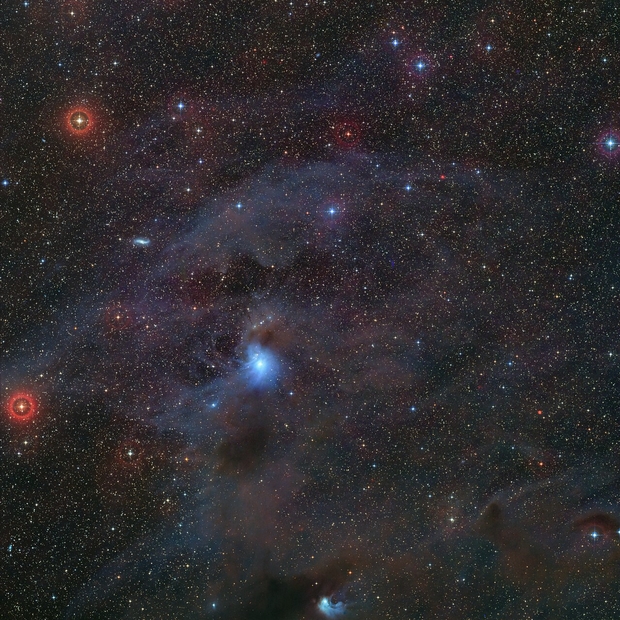
Image: This visible-light image, part of the Digitized Sky Survey 2, shows the position in the sky of the rogue planet Cha 1107-7626. The planet (not visible here) is located exactly at the centre of the frame. Credit: ESO/ Digitized Sky Survey 2.
The belief that rogue planets are invariably the result of ejections from a planetary system is challenged by these findings. From my reading of this paper, we seem to be looking at a ‘star-like’ formation of a gas giant through accretion, hinting at a variety of formation scenarios in free-floating worlds. Surely we will find more, but for now I can see why the authors call Cha1107-7626 “the poster child for disk accretion in the planetary-mass domain.”
The paper is Almendros-Abad et al., “Discovery of an Accretion Burst in a Free-Floating Planetary-Mass Object,” Volume 992, Number 1 (2 October 2025), L2 (full text).

A Potential Martian Biosignature 26 Sep 10:30 AM (2 months ago)
I’ve long maintained that we’ll find compelling biosignatures on an exoplanet sooner than we’ll find them in our own Solar System. But I’d love to be proven wrong. The recent flurry of news over the interesting findings from the Perseverance rover on Mars is somewhat reminiscent of the Clinton-era enthusiasm for the Martian meteorite ALH8001. Now there are signs, as Alex Tolley explains below, that this new work will prove just as controversial. Biosignatures will likely be suggestive rather than definitive, but Mars is a place we can get to, as our rovers prove. Will Perseverance compel the sample return mission that may be necessary to make the definitive call on life?
by Alex Tolley
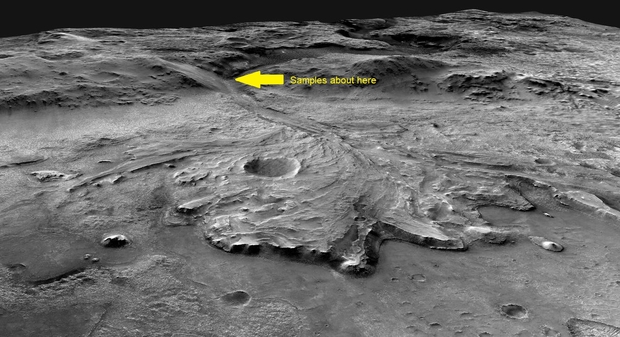
Overview of jezero Crater and sample site in article. Credit NASA/MSSS/USGS.
On September 10, 2025, Nature published an article that got wide attention. The authors claimed that they had discovered a possible biosignature on Mars. If confirmed, they would have won the race to find the first extraterrestrial biosignature. Exciting!
One major advantage of detecting a biosignature in our system is that we can access samples and therefore glean far more information than we can using spectroscopic data from an exoplanet. This will also reduce the ambiguity of simpler atmospheric gas analyses that are all we can do with our telescopes at present.

Figure 1. Perseverance’s path through Neretva Vallis and views of the Bright Angel formation. a, Orbital context image with the rover traverse overlain in white. White line and arrows show the direction of the rover traverse from the southern contact between the Margin Unit and Neretva Vallis to the Bright Angel outcrop area and then to the Masonic Temple outcrop area. Labelled orange triangles show the locations of proximity science targets discussed in the text. b, Mastcam-Z 360° image mosaic looking at the contact between the light-toned Bright Angel Formation (foreground) and the topographically higher-standing Margin Unit from within the Neretva Vallis channel. This mosaic was collected on sol 1178 from the location of the Walhalla Glades target before abrasion. Upslope, about 110 m distant, the approximate location of the Beaver Falls workspace (containing the targets Cheyava Falls, Apollo Temple and Steamboat Mountain and the Sapphire Canyon sample) is shown. Downslope, about 50 m distant, the approximate location of the target Grapevine Canyon is also shown. In the distance, at the southern side of Neretva Vallis, the Masonic Temple outcrop area is just visible. Mastcam-Z enhanced colour RGB cylindrical projection mosaic from sol 1178, sequence IDs zcam09219 and zcam09220, acquired at 63-mm focal length. A flyover of this area is available at https://www.youtube.com/watch?v=5FAYABW-c_Q. Scale bars (white), 100 m (a), 50 m (b, top) and 50 cm (b, bottom left). Credit: NASA/JPL-Caltech/ASU/MSSS.
Let’s back up for context. The various rover missions to Mars have proceeded to determine the history of Mars. From the Pathfinder mission starting in 1996, the first mission since the two 1976 Viking landers, the various rovers from Soujourner (1997), Spirit & Opportunity (2004), Curiosity (2012), and now Perseverance (2021), have increased the scope of their travels and instrument capabilities. NASA’s Perseverance rover was designed to characterize environments and look for signs of life in Jezero Crater, a site that was expected to be a likely place for life to have existed during the early, wet phase of a young Mars. The crater was believed to be a lake, fed by water running into it from what is now Neretva Vallis, and signs of a delta where the ancient river fed into the crater lake are clear from the high-resolution orbital images. Perseverance has been taking a scenic tour of the crater, making stops at various points of interest and taking samples. If there were life on Mars, this site would have both flowing water and a lake, with sediments that create a variety of habitats suitable for prokaryotic life, like the contemporary Earth.
Perseverance had taken images and samples of a sedimentary rock formation, which they called Bright Angel. The work involved using the Scanning Habitable Environments with Raman and Luminescence for Organics and Chemicals (SHERLOC) instrument to obtain a Raman UV spectrum of rock material from several samples. The authors claimed that they had detected 2 reduced iron minerals, greigite and vivianite, and organic carbon. The claim is that these have been observed in alkaline environments on Earth due to bacteria, and therefore prove to be a biosignature of fossil life. The images showed spots (figure 2) which could possibly be the minerals formed by the metabolism of anaerobic bacteria, reducing sulfur and iron for energy. The organic carbon in the mudstone rock matrix is the fossil remains of the bacteria living in the sediments.
Exciting, no? Possible proof that life once existed on Mars. The authors submitted a paper to Nature with the title, “Detection of a Potential Biosignature by the Perseverance Rover on Mars“. The title was clearly meant to catch the scientific and popular attention. At last, NASA’s “Follow the Water” strategy and exploration with their last rover equipped to detect biosignatures had found evidence of fossil life on Mars. It might also be a welcome boost for NASA’s science missions, currently under funding pressure from Congress.
Then the peer review started, and the story seemed less strong. Just as 30 years ago, when the announcement from the White House by the US president, Bill Clinton claimed that a Martian meteorite retrieved from the Antarctic, ALH8001, was evidence of life on Mars proved very controversial. Notably, slices of that meteorite viewed under an electron microscope showed images of what might have been some forms of bacteria. These images were seen around the world and were much discussed. The consensus was that the evidence was not unambiguous, with even the apparent “fossil bacteria” being explained as natural mineral structures.
Well, the new paper created one of the longest peer review documents I have ever read. Every claimed measurement and analysis was questioned, including the interpretation. The result was that the paper was published as the much drier “Redox-driven mineral and organic associations in Jezero Crater, Mars”. There are just 3 uses of the term biosignatures, each prefaced with the term “potential”, and the null hypothesis of abiotic origin emphasized as well. One of the three peer reviewers even wanted Nature to reject the paper, based on what might be another ALH8001 fiasco. A demand, too far.
What were the important potential biosignature findings?
Organisms extract energy from molecules via electron transfer. This often results in the compounds becoming more reduced. For example, sulfur-reducing bacteria convert sulfates (SO4) to sulfide (S). Iron may be reduced from its ferric (Fe3+) state to its ferrous (Fe2+) state. Two minerals that are often found reduced as a result of bacterial energy extraction are greigite Fe2+Fe3+2S4] and vivianite [Fe2+3(PO4)2·8H2O]. On Earth, these are regarded as biosignatures. In addition, unidentified carbon compounds were associated with these 2 minerals. The minerals were noticed as spots on the outcrop and identified with the Planetary Instrument for X-ray Lithochemistry (PIXL), which can identify elements via X-ray spectroscopy. The SHERLOC instrument identified the presence of carbon in association with these minerals.
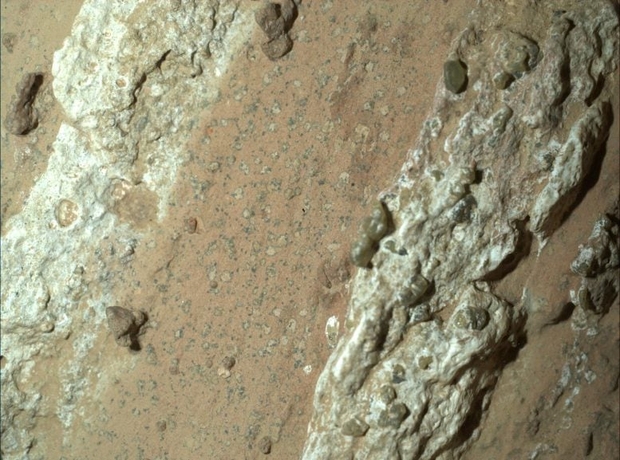
Figure 2. An image of the rock named “Cheyava Falls” in the “Bright Angel formation” in Jezero crater, Mars, collected by the WATSON camera onboard the Mars 2020 Perseverance rover. The image shows a rust-colored, organic matter in the sedimentary mudstone sandwiched between bright white layers of another composition. The small dark blue/green to black colored nodules and ring-shaped reaction fronts that have dark rims and bleached interiors are proposed to be potential biosignatures. Credit: NASA/JPL-Caltech/MSSS.
To determine whether the carbon associated with the greigite and vivianite was organic or inorganic, the material was subjected to ultraviolet rays. Organic carbon bonds, especially carbon-carbon bonds, will respond to specific wavelengths by vibrating, like sound frequencies can resonate and break wine glasses. Raman spectroscopy is the technique used to detect the resonant vibrations of types of carbon bonds, particularly specific arrangements of the atoms and their bonds that are common in organic carbon. The spectroscopic data indicated that the carbon material was organic, and therefore possibly from decayed organisms. This would tie together the findings of the carbon and the 2 minerals as a composite biosignature. However, the reviewers also questioned the interpretation of the Raman spectrum.. The sp2 carbon bonds (120 degrees) seen in aromatic 6-carbon rings, in graphene, graphite, and commonly in biotic compounds, should show both a G-band (around 1600 cm-1) and a D-band (around 2700 cm-1), yet the spectrum only clearly showed the G-band. Did this imply that the organic carbon may not have been found? The reviewers also questioned why the biological explanation was favored over an abiotic one. No one questioned the greigite and vivianite findings, other than that they are not exclusively associated with anaerobic bacterial metabolism.

Figure 3 – Raman spectrum with interpolated curves to highlight the G-band in the 4 samples taken at the location.
So what to make of this? Clearly, the authors backed down on their more positive interpretation of their findings as a biosignature.
What analyses would we want to do on Earth?
Assuming the samples from Perseverance are eventually retrieved and returned to Earth, what further analysis would we want to do to increase our belief that a biosignature was discovered?
A key analysis would be to analyze the carbon deposits. The Raman UV spectra indicate that the carbon is organic, which is almost a given. You may recall that the private MorningStar mission to Venus will do a similar analysis but use a laser-induced fluorescence that detects aromatic rings [1]. Neither of these techniques can distinguish between abiotic and biogenic carbon. The carbon may even be in the form of common polycyclic aromatic hydrocarbons (PAH), a form that is ubiquitous and is easily formed, especially with heat.
One useful approach to distinguish the source of the carbon is to measure the isotopic ratios of the 2 stable carbon isotopes, carbon-12 and carbon-13. Living organisms favor the lighter carbon-12, and therefore, the C13/C12 ratio is reduced when the carbon is from living organisms. This must be compared to known abiotic carbon to confirm its source. This analysis requires a mass spectrometer, which was not included with the Perseverance instrument pack.
The second approach is to analyze the carbon compounds. Gas chromatography followed by infrared spectroscopy is used to characterize the compounds. Life restricts the variety of compounds compared to random reactions, and can be compared to expectations based on Assembly Theory [2], although exposure to UV and particle radiation for billions of years may make the composition of the carbon more random.
Lastly, if the carbon were once protein or nucleotide macromolecules, any chirality might distinguish its source as biotic.
Isotopic analysis can also be made on the sulfur compounds in the greigite. As with carbon, life will preferentially use lighter isotopes. Bacteria reduce sulfate to sulfide for energy, and the iron sulfide mineral, greigite, is a waste product of this metabolism. Of the 2 stable sulfur isotopes, sulfur-32 and sulfur-34, if the S34/S32 ratio is reduced, then this hints that the greigite was formed biotically.
Lastly, opening up the samples and inspecting them with an electron microscope, there may be physical signs of bacteria. However, any physical features will need to be identified unambiguously to avoid the ALH8001 controversy.
Unfortunately for these proposed analyses, the Mars Sample Return (MSR) mission has been cut with the much-reduced NASA budget. When, or whether, we get these samples for analyses on Earth is currently unknown.
My view on the findings
If the findings and the interpretation of their compositions is correct, then this would probably be the most convincing, but still not unambiguous biosignature to date. If the samples are returned to Earth and the findings are extended with other analyses, then we probably would have detected fossil life on Mars. In my opinion, that would validate the idea that Martian life existed, and further exploration is warranted. We would then want to know if that life was similar or different from terrestrial life to shed light on abiogenesis or panspermia between Earth and Mars. As the formation of the Moon would have been very destructive, if life emerged on Mars and was spread to Earth, this might provide more time for living cells to evolve compared to the conditions on Earth. It would also stimulate the search for subsurface life on Mars, where interior heat and water between rock grains would support such a niche habitat as it does on Earth.
It seems a pity that without an MSR, we may have the evidence for Martian fossil life, packaged for analysis, but kept frustratingly remote and unavailable, mere millions of kilometers distant.
The paper is Hurowitz, J.A., Tice, M.M., Allwood, A.C. et al. “Redox-driven mineral and organic associations in Jezero Crater, Mars.” Nature 645, 332–340 (2025). https://doi.org/10.1038/s41586-025-09413-0
Other readings
Tolley A, (2022) Venus Life Finder: Scooping Big Science web: https://www.centauri-dreams.org/2022/06/03/venus-life-finder-scooping-big-science/
Walker, S. I., Mathis, C., Marshall, S., & Cronin, L. (2024). “Experimentally measured assembly indices are required to determine the threshold for life.” Journal of the Royal Society Interface, 21(220). https://doi.org/10.1098/rsif.2024.0367

Exoplanets: Refining the Target List 24 Sep 10:59 AM (2 months ago)
I wasn’t surprised to learn that the number of confirmed exoplanets had finally topped 6,000, a fact recently announced by NASA. After all, new worlds keep being added to NASA’s Exoplanet Science Institute at Caltech on a steady basis, all of them fodder for a site like this. But I have to admit to being startled by the fact that fully 8000 candidate planets are in queue. Remember that it usually takes a second detection method finding the candidate world for it to move into the confirmed ranks. That 8000 figure shows how much the velocity of discovery continues to increase.
The common theme behind much of the research is often cited as the need to find out if we are alone in the universe. Thus NASA’s Dawn Gelino, head of the agency’s Exoplanet Exploration Program (ExEP) at JPL:
“Each of the different types of planets we discover gives us information about the conditions under which planets can form and, ultimately, how common planets like Earth might be, and where we should be looking for them. If we want to find out if we’re alone in the universe, all of this knowledge is essential.”
I sometimes think, though, that the emphasis on an Earth 2.0 is over-stated. The search for other life is fascinating, but deepening our scientific knowledge of the cosmos is worthwhile even if we learn we are alone in the galaxy. What nature creates in bewildering variety merits our curiosity and deep study even on barren worlds. With ESA’s Gaia and NASA’s Roman Space Telescope in the mix, exoplanet detections will escalate dramatically. And a little further down the road is the Habitable Worlds Observatory, assuming we have the good sense to green-light the project and build it.
Bear in mind that almost all the known exoplanets are within a few thousand light years of Sol. We are truly awash in immensity. If there will ever be a complete catalog of the Milky Way’s planets, it will likely be from a Kardashev Type III civilization immensely older than ourselves. It’s fascinating to think that such a catalog might already exist somewhere. But it’s also fascinating to consider that we may be alone, which raises all kinds of questions about abiogenesis and the possible lifetime of civilizations.

Image: Scientists have found thousands of exoplanets (planets outside our solar system) throughout the galaxy. Most can be studied only indirectly, but scientists know they vary widely, as depicted in this artist’s concept, from small, rocky worlds and gas giants to water-rich planets and those as hot as stars. Credit: NASA’s Goddard Space Flight Center.
The idea of a large and growing catalog of exoplanets is the kind of thing I used to dream about as a kid reading science fiction magazines. Now we’re on the cusp of biosignature detection capabilities via the deep study of exoplanet atmospheres. Fewer than a hundred exoplanets have been directly imaged, a number that is likewise expected to rise with the help of the Roman instrument’s coronagraph. With new tools to better block out the overwhelming glare of the host star, we’ll be seeing gas giants in Jupiter-like orbits. That in itself is interesting – how many exoplanet systems have gas giants in such positions? Thus far, the Solar System pattern is rarely replicated.
The Fortunes of K2-18b
The sheer variety of planetary systems brings even more zest to this work. Consider the planet K2-18b, so recently in the news as the home of a possible global ocean, and one with prospects for life given all the parameters studied by a team at the University of Cambridge. It’s a fabulous scenario, but now we have a new study that questions whether sub-Neptunes like this are actually dominated by water. Caroline Dorn (ETH Zurich), co-author of the paper appearing in The Astrophysical Journal, believes that water on sub-Neptunes is far more limited than we have been thinking.
Here’s another demonstration of how our Solar System is so unlike what we’re finding elsewhere. Lacking a sub-Neptune among our own planets, we’re learning now that such worlds – larger than Earth but smaller than Neptune and cloaked in a thick atmosphere abundant in hydrogen and helium – are relatively common in our galaxy as, for that matter, are higher density but smaller ‘super-Earths.’ A global ocean seems to make sense if a sub-Neptune formed well beyond the snowline and brought a robust inventory of ice with it as it migrated into the warmer inner system. Indeed, the term Hycean (pronounced HY-shun) has been proposed to label a sub-Neptune planet with a deep ocean under an atmosphere rich in hydrogen.
The new paper examines the chemical coupling between the planet’s atmosphere and interior, with the authors assuming an early stage of formation in which sub-Neptunes go through a period dominated by a magma ocean. The hydrogen atmosphere helps to maintain this phase for millions of years. And the problem is that magma oceans have implications for the water content available. Using computer simulations to model silicates and metals in the magma, the team studied the chemical interactions that ensue. Most H20 water molecules are destroyed, with hydrogen and oxygen bonding into metallic compounds and disappearing deep into the planet’s interior.
From the paper:
Our results, which focus on the initial (birth) population of sub-Neptunes with magma oceans, suggest that their water mass fractions are not primarily set by the accretion of icy pebbles during formation but by chemical equilibration between the primordial atmosphere and the molten interior. None of the planets in our model, regardless of their initial H2O content, retain more than 1.5 wt% water after chemical equilibration. This excludes the high water mass fractions (10–90 wt%) invoked by Hycean-world scenarios (N. Madhusudhan et al. 2021), even for planets that initially accreted up to 30% H2O by mass. These findings are consistent with recent studies suggesting that only a small amount of water can be produced or retained endogenously in sub-Neptunes and super-Earths.
The work analyzes 19 chemical reactions and 26 components across the range of metals, silicates and gases, with the core composed of both metal and silicate phases. A computer model known as New Generation Planetary Population Synthesis (NGPPS) combines planetary formation and evolution and meshes with code developed for global thermodynamics. Thus a population of sub-Neptunes with magma oceans is generated, and consistently primordial water is destroyed by chemical interactions.
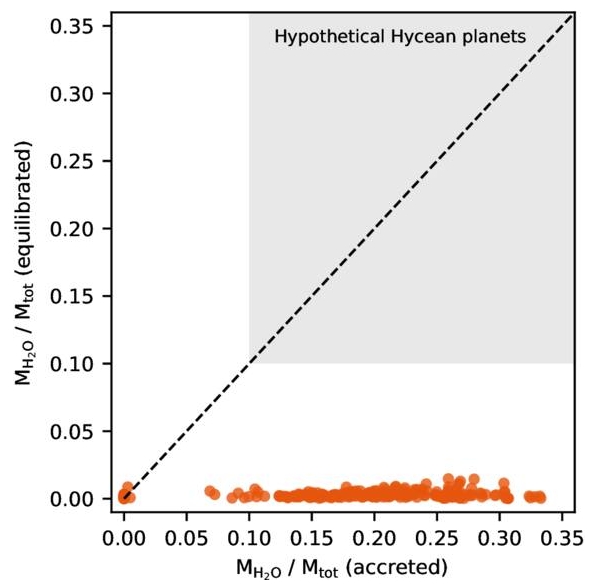
Image: This is Figure 3 from the paper. Caption: Envelope H2O mass fraction as a function of semimajor axis… The left panel shows planets that predominantly formed inside the water ice line; the right panel shows those that formed outside. Classification is based on the accreted H2O mass fraction, with a threshold set at 5% of the total planetary mass. The colorbar indicates the molar bulk C/O ratio. Planets formed inside the ice line are systematically depleted in carbon due to the lack of volatile ice accretion and exhibit higher envelope H2O mass fractions. In contrast, planets formed beyond the ice line retain lower H2O content despite higher bulk volatile abundances. Each pie chart shows the mean mass fraction of hydrogen in H2 (gas), H (metal), H2 (silicate), H2O (gas), and H2O (silicate), normalized to the total mean hydrogen inventory for each population. Only components contributing more than 5% are labeled. Planets that formed beyond the ice line store most hydrogen as H2 (gas) and H (metal), while those that formed inside the ice line retain a larger share of hydrogen in H (metal), H2 (silicate), and H2O (gas + silicate).. Credit: Werlen et al.
This is pretty stark reading if you’re fascinated with deep ocean scenarios. Here’s Dorn’s assessment:
“In the current study, we analysed how much water there is in total on these sub-Neptunes. According to the calculations, there are no distant worlds with massive layers of water where water makes up around 50 percent of the planet’s mass, as was previously thought. Hycean worlds with 10-90 percent water are therefore very unlikely.”
The paper is suggesting that we re-think what had seemed an obvious connection between planet formation beyond the snowline and water in the atmosphere. Instead, the interplay of magma ocean and atmosphere may deliver the verdict on the makeup of a planet. By this modeling, planets with atmospheres rich in water are more likely to have formed within the snowline. That leaves rocky worlds like Earth in the mix, but raises serious doubts about the viability of water in the sub-Neptune environment.
From the paper:
Counterintuitively, the planets with the most water-rich atmospheres are not those that accreted the most ice, but those that are depleted in hydrogen and carbon. These planets typically form inside the ice line and accrete less volatile-rich material. While some retain significant atmospheric H2O, the high-temperature miscibility of water and hydrogen likely prevents the presence of surface liquid water—even on these comparatively water-rich worlds.
This has broad implications for theories of planet formation and volatile evolution, as well as for interpreting exoplanet atmospheres in the era of the James Webb Space Telescope (JWST), the Extremely Large Telescope (ELT), ARIEL, the Habitable World Observatory (HWO), and the Large Interferometer for Exoplanets (LIFE). It also informs atmospheric composition priors in interior characterization of transiting planets observed by Kepler, TESS, CHEOPS, and PLATO with radial velocity (RV) or transit timing variation (TTV) constraints.
K2-18b will obviously receive continued deep study. But with an aggregate 14,000 exoplanets confirmed or listed as candidates, consider how overwhelmed our instruments are by sheer numbers. To do a deep dive into any one world demands the shrewdest calculations to find which exoplanets are most likely to reward the telescope time. This aspect of target selection will only get more critical as we proceed.
The paper is Werlen et al., “Sub-Neptunes Are Drier than They Seem: Rethinking the Origins of Water-rich Worlds,” Tje Astrophysical Journal Letters Vol. 991, No. 1 (18 September 2025), L16 (full text).

Beaming and Bandwidth: A New Note on the Wow! Signal 22 Sep 6:19 AM (2 months ago)
James Benford (president of Microwave Sciences, Lafayette CA) has just published a note in the Journal of the British Interplanetary Society that has relevance to our ongoing discussion of the Wow! Signal. My recent article was in the context of new work at Arecibo, where Abel Mendez and the Arecibo Wow! research effort have refined several parameters of the signal, detected in 1977 at Ohio State’s Big Ear Observatory. Let me slip in a quick look at Benford’s note before we move on from the Wow! Signal.
Benford has suggested both here and in other venues that the Wow! event can be explained as the result of an interstellar power beam intercepting our planet by sheer chance. Imagine if you will the kind of interstellar probe we’ve often discussed in these pages, one driven by a power beam to relativistic velocities. Just as our own high-powered radars scan the sky to detect nearby asteroids, a beam like this might sweep across a given planet and never recur in its sky.
But it’s quite interesting that in terms of the signal’s duration, bandwidth, frequency and power density, an interstellar power beam would be visible from another star system if this were to occur. All the observed features of such a beam are found in the Wow! Signal, which does not prove its nature, but suggests an explanation that corresponds with what data we have.
An interesting sidenote to this is, as Benford has discussed in these pages before, that if the Wow! Signal were an attempt to communicate, it should at some point repeat. Whereas a power beam from a source doing some kind of dedicated work in its system would never recur. We have had a number of attempts to find the Wow! Signal through the years but none have been successful.
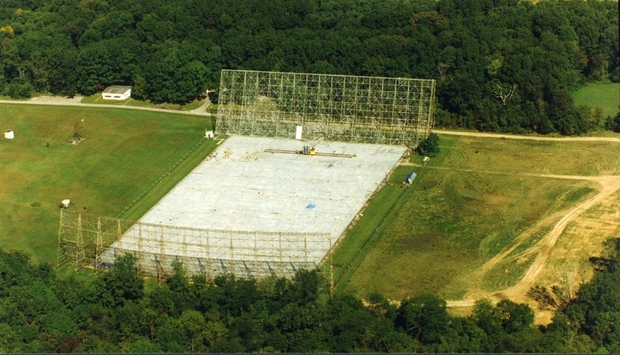
Image: The Ohio State University Radio Observatory in Delaware, Ohio, known as the Big Ear. Credit: By Иван Роква – Own work, CC BY-SA 4.0, via Wikimedia Commons.
The note in JBIS comes out of one of the Breakthrough Discuss meetings, where Michael Garrett (Jodrell Bank) asked Benford why, if a power beam explanation were the answer to the Wow!, a technical civilization would limit their beam to a narrow band of less than 10 kHz. It turns out there is an advantage in this, and that as Benford explains, narrow bandwidth is a requirement for high power-beaming systems in the first place.
Here I need to quote the text:
High power systems involving multiple sources are usually built using amplifiers, not oscillators, for several technical reasons. For example, the Breakthrough Starshot system concept has multiple laser amplifiers driven by a master oscillator, a so-called master oscillator-power amplifier (MOPA) configuration. Amplifiers are themselves characterized by the product of amplifier gain (power out divided by power in) and bandwidth, which is fixed for a given type of device, their ‘gain-bandwidth product.’ This product is due to phase and frequency desynchronization between the beam and electromagnetic field outside the frequency bandwidth.
Now we come to the crux. Power beaming to power up, say, an interstellar sail demands high power delivered to the target. To produce high power, each of the amplifiers involved must have small bandwidth, with the number of amplifiers used being determined by the power required. Benford puts it this way: “…you get narrow bandwidth by using very high-gain amplifiers to essentially ‘eat up’ the gain-bandwidth product.’
Thus we have a bandwidth limit for amplifiers, one that would apply both to beacons and power beams, which by their nature would be built to project high power levels. Small bandwidth is the physics-dictated result. None of this proves the nature of the Wow! Signal, but it offers an explanation that resonates with the fact that the four Wow! parameters are consistent with power beaming.

SETI Odds and Ends 15 Sep 6:39 AM (2 months ago)
I’m catching up with a lot of papers in my backlog, prompted by a rereading yesterday of David Kipping’s 2022 paper on the Wow! Signal, the intriguing, one-off reception at the Big Ear radio telescope in Ohio back in 1977 (Kipping citation below). I had just finished checking Abel Mendez’ work at Arecibo, where the Arecibo Wow! project has announced a new analysis based on study of previously unpublished observations using updated signal analysis techniques. No huge surprises here, but both Kipping’s work and Arecibo Wow! are evidence of our continuing fascination with what Kipping calls “the most compelling candidate for an alien radio transmission we have ever received.”

They also remind us that no matter how many times this intriguing event has been looked at, there are still new ways to approach it. I give the citation for the Mendez paper, written with a team of collaborators (one of whom is Kipping) below. Let me just pull this from Mendez’ statement on the Arecibo Wow! site, showing how the new work has refined the original Wow! Signal’s properties:
Location: Two adjacent sky fields, centered at right ascensions 19h 25m 02s ± 3s or 19h 27m 55s ± 3s, and declination –26° 57′ ± 20′ (J2000). This is both more precise and slightly shifted from earlier estimates.
Intensity: A peak flux density exceeding 250 Janskys, more than four times higher than the commonly cited value.
Frequency: 1420.726 MHz, placing it firmly in the hydrogen line but with a greater radial velocity than previously assumed.
Leading Mendez (University of Puerto Rico at Arecibo) to comment:
“Our results don’t solve the mystery of the Wow! Signal. “But they give us the clearest picture yet of what it was and where it came from. This new precision allows us to target future observations more effectively than ever before…. This study doesn’t close the case,” Méndez said. “It reopens it, but now with a much sharper map in hand.”
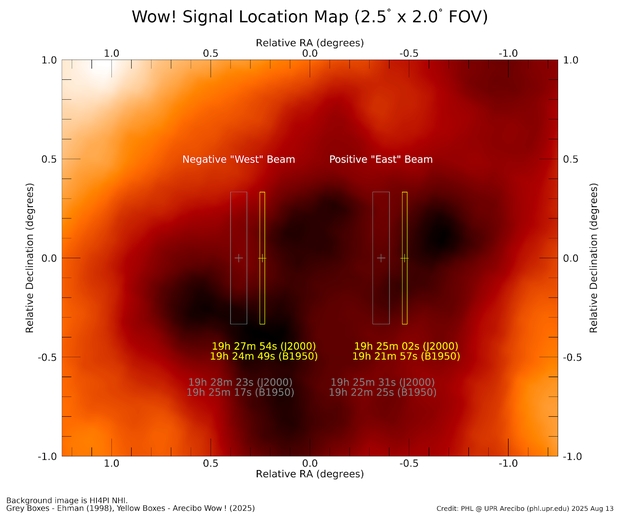
Image: Comparison of the previously estimated locations of the Wow! Signal (gray boxes) with the refined positions from the Arecibo Wow! Project (yellow boxes). The signal’s source is presumed to lie within one of these boxes and beyond the foreground Galactic hydrogen clouds shown in bright red. Credit: PHL @ UPR Arecibo.
Homing in on interesting anomalies is of course one way for SETI to proceed, although the host of later one-off detections from other locations (none evidently as powerful a signal as Wow!) doesn’t yield optimism that one of these will eventually repeat. A sweeping beam that by sheer chance swept across Earth from some kind of ETI installation? Works for me, if only we had repeating evidence. In the absence of it, we continue to dig into existing data using new techniques.
We can also proceed with targeted searches of nearby stars of interest both because of their proximity as well as the presence of unusual planetary configurations. The TRAPPIST-1 system isn’t remotely like ours, with its seven Earth-sized planets crammed into tight orbit around an M8V red dwarf star, but the fact that each of these transits makes the system of huge value. Now a team led by Guang-Yuan Song (Dezhou University, China) has used the FAST instrument (Five hundred meter Aperture Spherical Telescope) to search for SETI signals, delving into the frequency range 1.05–1.45GHz with a spectral resolution of ~7.5Hz. No signals detected, but the scientists plan to continue to search other nearby systems and do not rule out a return to this one. Citation below.
The Factors Leading to Technology
The frustration over lack of success at finding an extraterrestrial civilization is understandable, so it’s no surprise that theoretical work explaining it from an entirely opposite direction continues to appear. As witness a new study just presented at the EPSC-DPS Joint Meeting 2025 in Helsinki. Here we’re asking what factors go into making a technological society possible, assuming an evolutionary history something like our own, and probing whether changes to any of the parameters that helped us emerge would have made us impossible.
All this goes back to the 1960s and the original Drake Equation, which makes a loose attempt at sizing up the possibilities. Manuel Scherf and Helmut Lammer of the Space Research Institute at the Austrian Academy of Sciences in Graz paint a distressing picture for those intent on plucking a signal from ETI out of the ether. Their work has focused on plate tectonics and its relationship with the critical gas carbon dioxide, which governs the carbon-silicate cycle.
CO2 is a huge factor in sustaining photosynthesis, but too much of it creates greenhouse effects that can likewise spell the end of life on a planet like ours. The fine-tuning that goes on through the carbon-silicate cycle ensures that CO2 gets released back into the atmosphere through plate tectonics and volcanic emissions, recycling it back out of the rock in which it had been previously locked. Scherf pointed out to the EPSC-DPS gathering that if we wait somewhere between 200 million and one billion years, loss of atmospheric CO2 will bring an end to photosynthesis. The Sun may have another five billion years of life ahead, but the environment that sustains us won’t last nearly as long.
Indeed, the researchers argue, surface partial pressures and mixing ratios of CO2, O2, and N2 likewise affect such things as combustion, needed for the smelting of metals that underpins the growth of a technological civilization. Imagine a planet with 10 percent of its atmosphere taken up by CO2 (as opposed to the 0.042 percent now found on Earth). This world produces a biosphere that can sustain itself against a runaway greenhouse if further away from its star than we are from the Sun, but it would also require no less than 18 percent oxygen (Earth now has 21 percent) to ensure that combustion can occur.
If we do away with plate tectonics, so critical to the carbon-silicate cycle, we likewise limit habitable conditions at the surface. So we need this as well as enough oxygen to provide combustion to make technology possible. In other words, we have astrophysical, geophysical, and biochemical criteria that have to be met even when a planet is in the habitable zone if we are hoping to find lifeforms that have survived long enough to create technology. Rare Earth?
Scherf and Lammer weigh these factors against the amount of time it takes technology to emerge, assuming that the longer an ETI civilization exists, the more likely we are to observe it. Here I don’t have a paper to work with, so I can only report the conclusions presented at the EPSC-DPS conference, which are stated bluntly by Scherf:
“For 10 civilizations to exist at the same time as ours, the average lifetime must be above 10 million years. The numbers of ETIs are pretty low and depend strongly upon the lifetime of a civilization.”
I can also fall back on a 2024 paper from the same team discussing these matters, which delves not only into the question of the perhaps rare combination of circumstances which allows for technological civilizations to emerge but also our use of the Copernican Principle in framing the issues:
…our study is agnostic about life originating on hypothetical habitats other than EHs. Any more exotic habitats (e.g., subsurface ocean worlds) could significantly outnumber planets with Earthlike atmospheres, at least in principle. Finally, we argue that the Copernican Principle of Mediocrity cannot be valid in the sense of the Earth and consequently complex life being common in the Galaxy. Certain requirements must be met to allow for the existence of EHs and only a small fraction of planets indeed meet such criteria. It is therefore unscientific to deduce complex aerobic life to be common in the Universe, at least based on the Copernican Principle. Instead, we argue, at maximum, for a combined Anthropic-Copernican Principle stating that life as we know it may be common, as long as certain criteria are met to allow for its existence. Extremophiles, anaerobic and simple aerobic lifeforms, however, could be more common.
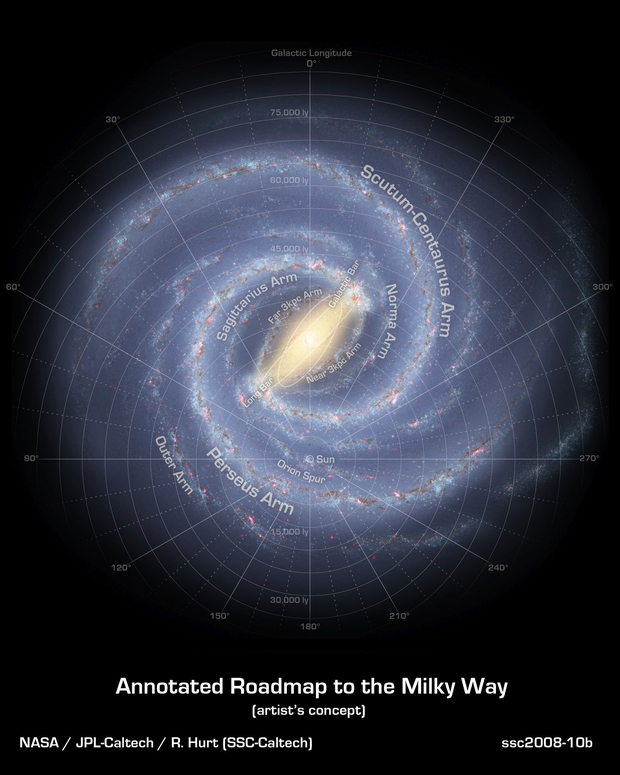
Image: An artist’s impression of our Milky Way Galaxy, showing the location of the Sun. Our Solar System is about 27,000 light years from the centre of the galaxy. The nearest technological species could be 33,000 light years away. Credit: NASA/JPL–Caltech/R. Hurt (SSC–Caltech).
All of which illuminates the paucity of data. We could say that it took four and a half billion years for technology to emerge on Earth, but that is our only reference point. We also have no data on how long technological societies exist. It is clear, though, that the longer the survival period, the more likely we are to be present in the cosmos at the same time they are. For there to be even one technological civilization in the galaxy coinciding with our existence, ETI would have to have survived in a technological phase for at least 280,000 years. I think that matches up with the case Brian Lacki has been making for some time now, which emphasizes the ‘windows’ of time within which we view the cosmos.
But Scherf adds this:
“Although ETIs might be rare there is only one way to really find out and that is by searching for it. If these searches find nothing, it makes our theory more likely, and if SETI does find something, then it will be one of the biggest scientific breakthroughs ever achieved as we would know that we are not alone in the Universe.”
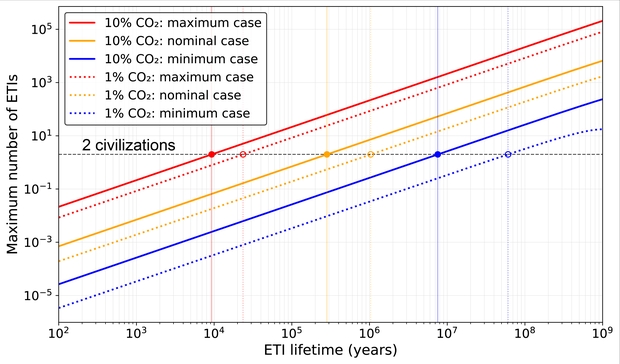
Image: This graph shows the maximum number of ETIs presently existing in the Milky Way. The solid orange line describes the scenario of planets with nitrogen–oxygen atmospheres with 10 per cent carbon dioxide. In this case the average lifetime of a civilization must be at least 280,000 years for a second civilization to exist in the Milky Way. Changing the amount of atmospheric carbon dioxide produces different results. Credit: Manuel Scherf and Helmut Lammer.
I’ll note in passing that Adam Frank (Rochester Institute of Technology) and Amedeo Balbi (University of Rome Tor Vergata) have analyzed the question of an ‘oxygen bottleneck’ for the emergence of technology in a recent paper in Nature Astronomy. The memorable thought that if there are no other civilizations in the galaxy, it’s a tremendous waste of space sounds reasonable only if we have fully worked out how likely any planet is to be habitable. This new direction of astrobiological research tells me we have a long way to go.
The Mendez paper is Mendez et al., “Arecibo Wow! II: Revised Properties of the Wow! Signal from Archival Ohio SETI Data,” currently available as a preprint but submitted to The Astrophysical Journal. The Kipping paper from 2022 is Kipping & Gray, “Could the ‘Wow’ signal have originated from a stochastic repeating beacon?” Monthly Notices of the Royal Astronomical Society, Volume 515, Issue 1 (September 2022), pp.1122-1129 (full text). Thanks to my friend Antonio Tavani for the heads-up on the Mendez paper. The paper on the FAST search of TRAPPIST-1 is Guang-Yuan Song et al., “A Deep SETI Search for Technosignatures in the TRAPPIST-1 System with FAST,” submitted to The Astrophysical Journal and available as a preprint.
The Scherf and Lammer presentation is titled “How common are biological ETIs in the Galaxy?” EPSC-DPS Joint Meeting 2025, Helsinki, Finland, 7–12 Sep 2025, EPSC-DPS2025-1512. The abstract is available here. The same team’s 2024 paper on these matters is “Scherf et al. “Eta-Earth Revisited II: Deriving a Maximum Number of Earth-Like Habitats in the Galactic Disk,” Astrobiology 24 (2023), e916 (full text). The paper from Adam Frank is Frank & Balbi, “The oxygen bottleneck for technospheres,” Nature Astronomy 8 (2024), pp. 39–43 (abstract / preprint).
And I want to be sure to mention Robert Gray, Kipping’s co-author on his 2022 paper, who devoted years to the study of the Wow! Signal and was kind enough to write about his quest in these pages. If you’re not familiar with Gray’s work, I hope you’ll read my An Appreciation of SETI’s Robert Gray (1948-2021). I only wish I had gotten to know him better. His death was a loss to the entire community. David Kipping’s fine video covering his work with Gray is available at Cool Worlds. Keith Cooper also explicates this paper in One Man’s Quest to Investigate the Mysterious “Wow!” Signal.

Stitching the Stars: Graphene’s Fractal Leap Toward a Space Elevator 10 Sep 7:47 AM (3 months ago)
The advantages of a space elevator have been percolating through the aerospace community for quite some time, particularly boosted by Arthur C. Clarke’s novel The Fountains of Paradise (1979). The challenge is to create the kind of material that could make such a structure possible. Today, long-time Centauri Dreams reader Adam Kiil tackles the question with his analysis of a new concept in producing graphene, one which could allow us to create the extraordinarily strong cables needed. Adam is a satellite image analyst located in Perth, Australia. While he has nursed a long-time interest in advanced materials and their applications, he also describes himself as a passionate advocate for space exploration and an amateur astronomer. Today he invites readers to imagine a new era of space travel enabled by technologies that literally reach from Earth to the sky.
by Adam Kiil
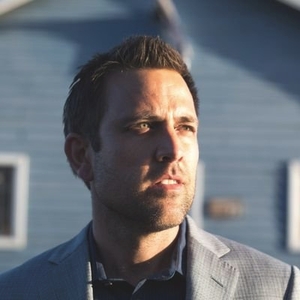
In the quiet predawn hours, a spider spins its web, threading together a marvel of biological engineering: strands that are lightweight, elastic, and capable of absorbing tremendous energy before failing. This isn’t just nature’s artistry; it’s a lesson in hierarchical design, where proteins self-assemble into beta-pleated sheets and amorphous regions, creating a material tougher than Kevlar — able to dissipate impacts like a shock absorber — while outperforming steel in strength-to-weight ratio, though falling short of Kevlar’s raw tensile strength.
As we gaze upward toward the stars, dreaming of bridges to orbit, such bio-inspired ingenuity beckons. Could we mimic this to construct a space elevator tether, a ribbon stretching 100,000 kilometers from Earth’s equator to geostationary orbit and beyond? The demands are staggering: a material with a specific strength exceeding 50 GPa·cm³/g to support its own weight against gravity’s pull, all while withstanding radiation, micrometeorites, and immense tensile stresses. [GPa is a reference to gigapascals, the units used to measure tensile strength at high pressures and stresses. Thus GPa·cm³/g represents the ratio of strength to density].
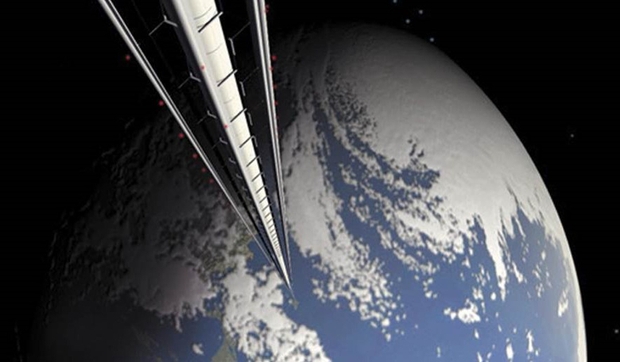
Image: A space elevator is a revolutionary transportation system designed to connect Earth’s surface to geostationary orbit and beyond, utilizing a strong, lightweight cable – potentially made of graphene due to its extraordinary tensile strength and low density—anchored to an equatorial base station and extending tens of thousands of kilometers to a counterweight in space. This megastructure would enable low-cost, efficient transport of payloads and people into orbit, leveraging a climber mechanism that ascends the cable, potentially transforming space access by reducing reliance on traditional rocket launches. Credit: Pat Rawlings/NASA.
Enter a recent breakthrough in graphene production from professor Chris Sorensen at Kansas State University and Vancouver-based HydroGraph Clean Power, whose detonation synthesis yields pristine, fractal, and reactive graphene — potentially a key ingredient in weaving this cosmic thread.
But this alone may not suffice; we must think from first principles, exploring uncharted solutions to assemble nanoscale wonders into macroscale might.
Graphene’s Promise and Perils: The Historical Context
Graphene, that atomic-thin honeycomb of carbon, tantalizes with its theoretical tensile strength of 130 GPa and density of 2.2 g/cm³, yielding a specific strength around 59 GPa·cm³/g—right on the cusp of space elevator viability.
Yet, production has long been the bottleneck. Chemical vapor deposition churns out high-quality but limited sheets; mechanical exfoliation delivers impure, aggregated flakes. These yield composites where graphene platelets, bound weakly by van der Waals forces (mere 0.1-1 GPa), slip under strain, like loose pages in a book. For a tether, we need seamless load transfer, hierarchical reinforcement, and defect minimization—echoing the energy-dissipating nanocrystals in spider silk’s protein matrix.
Sorensen’s Detonation Concept: Fractal and Reactive Graphene
Chris Sorensen’s innovation at HydroGraph Clean Power flips the script. Using a controlled detonation of acetylene and oxygen in a sealed chamber, his team produces graphene with over 99.8% purity, fractal morphology, and tunable reactivity—all at scale, with zero waste and low emissions.
The fractal form — branched, snowflake-like platelets with 200 m²/g surface area — enhances interlocking, outperforming traditional graphene by 10-100 times in composites, but crucially, these gains shine at ultra-low loadings (0.001%) and under modest stresses, not yet the gigapascal realms of a space elevator.
Reactive variants add edge functional groups like carboxylic acids (COOH), enabling covalent bonding—yet, note that simple condensation reactions here yield strengths akin to polymer chains (1-5 GPa), not the in-plane prowess of graphene’s sp² lattice.This fractal graphene could form a foundational scaffold, reconfigurable into aligned structures that mimic bone’s porosity or silk’s hierarchy. Earthly spin-offs abound: tougher concrete, sensitive sensors, efficient batteries. But for the stars, we must bridge the gap from nanoplatelets to kilometer-long cables.

Image: Conceptual view of Hydrographs’ turbostratic, 50nm nanoplatelets, 99.8% pure carbon, sp2 bonded graphene. Credit: Adam Kiil.
From First Principles: Many Paths to a Cosmic Thread
To transcend these limits, let’s reason from fundamentals. A space elevator tether must maximize tensile strength while minimizing density and defects, distributing stress across scales like spider silk’s beta-sheets (crystalline strength) embedded in an extensible amorphous matrix.
Graphene’s strength derives from its delocalized electrons in a defect-free lattice; any assembly must preserve this while forging inter-platelet bonds rivaling intra-platelet ones. Current methods fall short, so here are myriad speculative solutions, drawn from physics, chemistry, and biology—some extant, others nascent or hypothetical, demanding innovation:
- Edge-Fusion via Plasma or Laser Annealing: Functionalize edges with hydrogen or halogens, then use plasma arcs or femtosecond lasers to fuse platelets into seamless, extended sheets or ribbons, healing defects to approach single-crystal continuity. This could yield tensile strengths nearing 100 GPa by eliminating weak interfaces.
- Supramolecular Self-Assembly in Liquid Crystals: Disperse fractal graphene in nematic solvents, applying shear or electric fields to align platelets into helical fibrils, stabilized by pi-pi stacking and hydrogen bonding. Inspired by silk’s pH-induced assembly, this bottom-up approach might create defect-tolerant bundles with built-in energy dissipation.
- Bio-Templating with Engineered Proteins: Design peptides (via AI like AlphaFold) that bind graphene edges, mimicking silk spidroins’ repetitive motifs to fold platelets into hierarchical nanocrystals. Extrude through microfluidic spinnerets, acidifying to trigger beta-sheet formation, embedding graphene in a tough, elastic matrix.
- Covalent Cross-Linking with Boron or Nitrogen Dopants: Introduce boron atoms during detonation to create sp³ bridges between platelets, forming diamond-like nodes in a graphene network. This could boost shear strength to 10-20 GPa without sacrificing tensile properties, verified by molecular dynamics.
- Electrospinning with Magnetic Alignment: Mix reactive graphene in a polymer dope, electrospin under magnetic fields to orient platelets, then pyrolyze the polymer, leaving aligned, sintered graphene fibers. Enhancements: Add ultrasonic waves for dynamic packing, targeting <1 defect per 100 nm².
- Hierarchical Bundling via 3D Printing: Nanoscale print graphene inks layer-by-layer, using click chemistry (e.g., thiol-ene) for instant cross-links. Scale up to micro-bundles, then macro-cables, tapering density like a tree trunk to root.
- Dynamic Compression and Sintering: Apply gigapascal pressures in a diamond anvil cell, combined with heat, to induce partial sp²-to-sp³ transitions at overlaps, creating hybrid structures akin to lonsdaleite—ultra-hard yet flexible.
- Biomineralization Analogs: Introduce calcium or silica ions to reactive groups, mineralizing interfaces like nacre, adding compressive strength and crack deflection.
- AI-Optimized Hybrid Composites: Simulate (via quantum computing) blends of fractal graphene with silk-mimetic polymers or boron nitride, optimizing ratios for 90% tensile efficiency. Fabricate via wet-spinning, testing at centimeter scales.
These aren’t exhaustive; hybrids abound—e.g., combining bio-templating with laser fusion. Each target’s aim: moving beyond low-load enhancements and polymer-like bonds to harness graphene’s full lattice strength.
Weaving and Laminating: Practical Steps Forward
Drawing from these, a viable process might start with a high-solids dispersion of reactive fractal graphene, extruded via wet-spinning into aligned fibers, where optimized cross-linkers (not mere condensations) ensure graphene-dominant strength. Stack into nacre-like laminates, using hot isostatic pressing (5-20 GPa) to forge sp³ bonds, elevating shear (and thus overall tensile) resilience to 10-20 GPa. Taper the structure: thick at the base for 7 GPa stresses, thinning upward.
Scaling leverages HydroGraph’s modular reactors, producing tonnage graphene for kilometer segments.
Join via overlap lamination, braid for redundancy, deploy from orbit. Prototypes must demonstrate cohesive failure, >90% load transfer, via nanoindentation.
A Bridge to the Cosmos
Sorensen’s detonation-born graphene, fractal and reactive, ignites possibility. Yet, as spider silk teaches, true mastery lies in hierarchy and adaptation.
Success means a tether with inter-platelet bond strength nearing single-crystal graphene (>100 GPa), verified by nanoindentation or pull-out tests, with >90% tensile transfer efficiency. Centimetre-scale prototypes should show minimal defects (<1 per 100 nm² via TEM), failing cohesively, not delaminating, like a spider’s web holding under a gale. The full tether, massing under 500 tonnes, could be deployed from orbit, a lifeline to the cosmos. This graphene tether embodies our ‘sea-longing,’ a bridge to the stars woven from carbon’s hexagons, inspired by nature’s spinners and builders.
By innovating from first principles—fusing, assembling, templating—we edge closer to stitching the stars. This isn’t mere materials science; it’s the warp and weft of humanity’s interstellar tapestry, a web to catch the dreams of Centauri and beyond.

3I/ATLAS: The Case for an Encounter 6 Sep 5:57 AM (3 months ago)
The science of interstellar objects is moving swiftly. Now that we have the third ‘interloper’ into our Solar System (3I/ATLAS), we can consider how many more such visitors we’re going to find with new instruments like the Vera Rubin Observatory, with its full-sky images from Cerro Pachón in Chile. As many as 10,000 interstellar objects may pass inside Neptune’s orbit in any given year, according to information from the Southwest Research Institute (SwRI).
The Gemini South Observatory, likewise at Cerro Pachón, has used its Gemini Multi-Object Spectrograph (GMOS) to produce new images of 3I/ATLAS. The image below was captured during a public outreach session organized by the National Science Foundation’s NOIRLab and the Shadow the Scientists initiative that seeks to connect citizen scientists with high-end observatories.
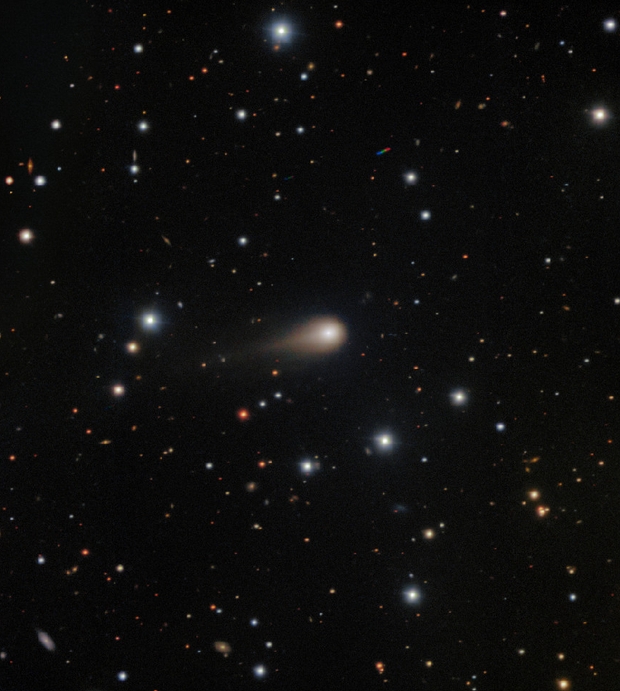
Image: Astronomers and students working together through a unique educational initiative have obtained a striking new image of the growing tail of interstellar Comet 3I/ATLAS. The observations reveal a prominent tail and glowing coma from this celestial visitor, while also providing new scientific measurements of its colors and composition. Credit: Gemini Observatory/NSF NOIRlab.
Immediately obvious is the growing size of the coma, the cloud of dust and gas enveloping the nucleus as 3I/ATLAS moves closer to the Sun and continues to warm. Analyzing spectroscopic data will allow scientists to understand more about the object’s chemistry. So far we’re seeing cometary dust and ice not dissimilar to comets in our own system. We won’t have this object long, as its orbit is hyperbolic, taking it inside the orbit of Mars and then off again into interstellar space. Perihelion should occur at the end of October. It’s interesting to consider, as Marshall Eubanks and colleagues do in a new paper, whether we already have spacecraft that can learn something further about this particular visitor.
Note this from the paper (citation below):
Terrestrial observations from Earth will be difficult or impossible roughly from early October through the first week of November, 2025… [T]he observational burden during this period will, to the extent that they can observe, largely fall on the Psyche and Juice spacecraft and the armada of spacecraft on and orbiting Mars. Our recommendation is that attempts should be made to acquire imagery from encounter spacecraft during the entire period of the passage of 3I through the inner solar system, and in particular from the period in October and November of 2025, when observations from Earth and the space telescopes will be limited by 3I’s passage behind the Sun from those vantage points.
As we consider future interstellar encounters, flybys begin to look possible. Such was the conclusion of an internal research study performed at SwRI, which examined costs and design possibilities for a mission that may become a proposal to NASA. SwRI was working with software that could create a large number of simulated interstellar objects, while at the same time calculating a trajectory from Earth to each. Matthew Freeman is project manager for the study. It turns out that the new visitor is itself within the study’s purview:
“The trajectory of 3I/ATLAS is within the interceptable range of the mission we designed, and the scientific observations made during such a flyby would be groundbreaking. The proposed mission would be a high-speed, head-on flyby that would collect a large amount of valuable data and could also serve as a model for future missions to other ISCs [interstellar comets].”

Image: Upper left panel: Comet 3I/ATLAS as observed soon after its discovery. Upper right panel: Halley’s comet’s solid body as viewed up close by ESA’s Giotto spacecraft. Lower panel: The path of comet 3I/Atlas relative to the planets Mercury through Saturn and the SwRI mission interceptor study trajectory if the mission were to be launched this year. The red arc in the bottom panel is the mission trajectory from Earth to interstellar comet 3I/ATLAS. Courtesy of NASA/ESA/UCLA/MPS.
So we’re beginning to undertake the study of actual objects from other stellar systems, and considering the ways that probes on fast flyby missions could reach them. 3I/ATLAS thus makes the case for further studies of flyby missions. SwRI’s Mark Tapley, an expert in orbital mechanics, is optimistic indeed:
“The very encouraging thing about the appearance of 3I/ATLAS is that it further strengthens the case that our study for an ISC mission made. We demonstrated that it doesn’t take anything harder than the technologies and launch performance like missions that NASA has already flown to encounter these interstellar comets.”
The paper on a fast flyby mission to an interstellar object is Eubanks et al., “3I/ATLAS (C/2025 N1): Direct Spacecraft Exploration of a Possible Relic of Planetary Formation at “Cosmic Noon,” available as a preprint.

Ancient Life on Ceres? 3 Sep 10:51 AM (3 months ago)
We keep going through revolutions in the way science fiction writers handle asteroids. Discovered in 1801, Ceres and later Pallas (1802) spawned the notion that there once existed a planet where what came to be thought of as the asteroid belt now exists. Heinrich Olbers was thinking of the Titius-Bode law when he suggested this, pointing to the mathematical consistency of planetary orbits implicit in the now discredited theory. Robert Cromie wrote a novel called Crack of Doom in 1895 that imagined a fifth planet blown apart by futuristic warfare, a notion picked up by many early science fiction writers.
Nowadays, that notion seems quaint, and asteroids more commonly appear in later SF either as resource stockpiles or terraformed habitats, perhaps hollowed out to become starships. Nonetheless, there was a flurry of interest in asteroids as home to extraterrestrial life in the 1930s (thus Clark Ashton Smith’s “Master of the Asteroid”), and actually none other than Konstantin Tsiolkovsky wrote an even earlier work called “On Vesta” (1896), where he imagines a technological civilization emerging on the asteroid. Before someone writes to scold me for leaving it out, I have to add that Antoine de Saint-Exupéry’s The Little Prince (1943) assumes an asteroid as the character’s home world.
The Dawn mission that did so much to reveal the surface of Ceres made it clear how cold and seemingly inimical to life this largest of all asteroids seems to be. But even here, there is new speculation about a warmer past and the possibility of at least primitive life emerging under the frigid surface. The reservoir of interior salty water whose surface residue can be seen in Ceres’ reflective regions now appears, via Dawn data, to contain carbon molecules. So we have water, carbon molecules and a likely source of chemical energy here.

Image: Dwarf planet Ceres is shown in these enhanced-color renderings that use images from NASA’s Dawn mission. New thermal and chemical models that rely on the mission’s data indicate Ceres may have long ago had conditions suitable for life. Credit: NASA/JPL-Caltech/UCLA/MPS/DLR/IDA.
The new work from lead author Samuel Courville (Arizona State University) and team is built around computer models of Ceres, looking at its chemistry and thermal characteristics since the early days of the Solar System. The evidence shows that as late as 2.5 billion years ago, the asteroid’s internal ocean was still being heated by radioactive decay of elements deep in the interior, providing dissolved gases carried by upwelling hot water exposed to the rocks in Ceres’ core.
That’s a significant marker, because we know that here on Earth, mixing hot water, metamorphic rock and ocean provides everything life needs. Demonstrating that Ceres once had hydrothermal fluid feeding into its ocean would imply that microbes could have formed there, even if today they are long gone. Today heat from radioactive decay should be insufficient to keep Ceres’ water from turning into a concentrated brine, but the situation several billion years ago was similar to that of many Solar System objects which lack any source of tidal heating because they do not orbit a large planet.
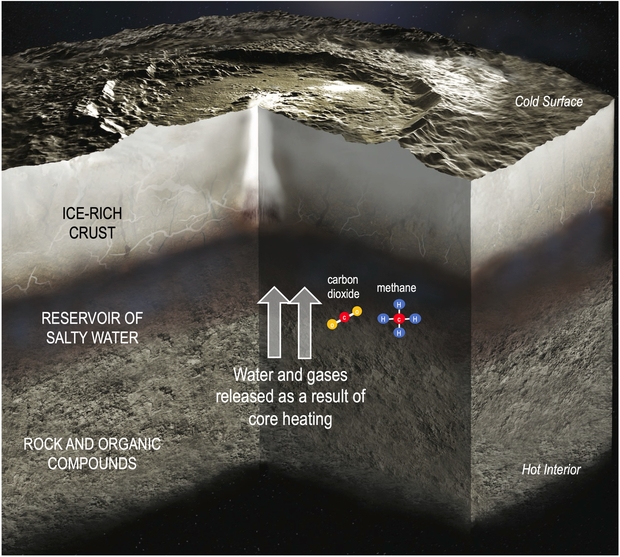
Image: This illustration depicts the interior of dwarf planet Ceres, including the transfer of water and gases from the rocky core to a reservoir of salty water. Carbon dioxide and methane are among the molecules carrying chemical energy beneath Ceres’ surface. Credit: NASA/JPL-Caltech.
From the paper:
Since Ceres is not subject to as many complex evolutionary factors (e.g., tidal heating) as are many other candidate ocean worlds that orbit gas giants, it is an ideal body to study evolutionary pathways relevant to candidate ocean worlds in the ~500- to 1000-km radius range. Being in large numbers, these bodies might represent the most abundant type of habitable environment in the early solar system.
An interesting thought! We can even speculate on how long this window of astrobiological opportunity might have remained open:
From a chemical energy perspective, the most habitable periods for these objects were when the rocky interiors underwent thermal metamorphism. Metamorphism leads to an influx of fluids into the ocean. These fluids could provide a steady source of chemical disequilibrium for several hundred million years. In the case of Ceres, the metamorphic period between ~0.5 and 2 Gyr would have created a potentially habitable environment at the seafloor if the rocky mantle reached temperatures greater than ~700 K. The decreasing temperature of Ceres’s interior over the past ~1 Gyr would likely render it thermodynamically inactive at present.
A sample return mission to Ceres? Such is recommended as a New Frontiers mission in the decadal survey Origins, worlds, and life: a decadal strategy for planetary science and astrobiology 2023–2032 (The National Academies Press, 2022). The document cites the need for samples “…collected from young carbonate salt deposits, typified by those identified by the Dawn mission at Occator crater, as well as some of Ceres’s typical dark materials.”
The paper is Courville et al., “Core metamorphism controls the dynamic habitability of mid-sized ocean worlds—The case of Ceres,” Science Advances Vol. 11 Issue 34 (20 August 2025). Full text.

Amazing Worlds: A Review 29 Aug 8:34 AM (3 months ago)
I hardly ever watch a film version of a book I love because my mental images from the book get mangled by the film maker’s vision. There’s also the problem of changes to the plot, since film and novels are entirely different kinds of media. The outliers, though, are interesting (and I sure did love Bladerunner). And when I heard that AppleTV would do Asimov’s Foundation books, I resolved to watch because I was satisfied there was no way on Earth my book images would conflict with what a filmmaker might do. How could anyone possibly produce a film version of these books?
Judging from the comments I see online, a lot of people realize how remote the AppleTV series is from the source. But here we get into something interesting about the nature of science fiction, and it’s something I have been thinking about since reading Keith Cooper’s book Amazing Worlds of Science Fiction and Science Fact. For the streaming variant of Foundation is visually gorgeous, and it pulls a lot of taut issues out of what I can only describe as the shell or scaffolding of the Asimov titles. Good science fiction is organic, and can grow into productive new directions.
A case in point: The ‘moonshrikes.’ They may not be in the books, but what a marvelous addition to the story. These winged creatures the size of elephants take advantage of another science fictional setting, a ‘double planet,’ two worlds so tightly bound that their atmospheres mix. You may remember Robert Forward playing around with this idea in his novel Rocheworld (1990), and to my knowledge that is the fictional origin of what appears to be a configuration well within the laws of physics. In the streaming Foundation, a scene where Hari Seldon watches moonshrikes leaping off cliffs to soar into the sky and graze on the sister world is pure magic.
Keith Cooper is all about explaining how this kind of magic works, and he goes at the task in both literary and filmed science fiction. Because the topic is the connection between real worlds and imagined ones, he dwells on that variant of science fiction called ‘hard SF’ to distinguish it from fantasy. As we’ve seen recently in talking about neutron stars and possible life forms there, the key is to imagine something that seems fantastic and demonstrate that it is inherently plausible. Asimov could do this, as could Clarke, as could Heinlein, and of course the genre continues into Benford, Baxter, Vinge, Reynolds, Niven and so on.
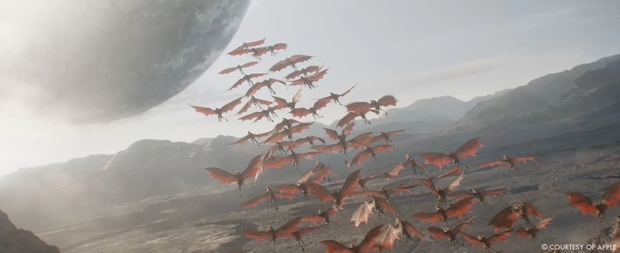
Image: The moonshrikes take wing. Credit: AppleTV / Art of VFX.
It’s hard to know where to stop with lists like that (and yes, I should mention Brin and Bear and many more), but the point is, this is the major thrust of science fiction, and while AppleTV’s Foundation takes off on explorations far from the novels, its lush filmography contains within it concepts that have been shrewdly imagined and presented with lavish attention to detail. Other worlds, as Keith Cooper will remind us in his fine book, are inescapably alien, yet they can be (at least to our imaginations, since we can’t directly see most of them yet) astonishingly beautiful. Cooper’s intuitive eye gets all that.
The rich history of science fiction, from the pulp era through to today’s multimedia extravaganzas, gets plenty of attention. I’m pleased to report that Cooper’s knowledge of SF history is deep and he moves with ease through its various eras. His method is to interview and quote numerous writers on the science behind their work, and numerous scientists on the origins of their interest. Thus Alison Sinclair, whose 1996 novel Blueheart takes place on an ocean world. Sinclair, a biochemist with a strong background in neuroscience, knows about the interplay between the real and the imagined.
Sinclair talks about how Blueheart’s ocean, being warmer and less salty than Earth’s oceans on average, is therefore less dense and floats atop a deeper layer of denser water. The aquatic life on Blueheart lives in that top layer, but when that life dies its remains, along with the nutrients those remains contain, would sink right to the bottom of the dense layer. She raises an additional point that on Earth, deep water is mixed with surface water by winds that drive surface water away from coasts, allowing deep water to well up, but with no continents on Blueheart there are no coasts, and with barely any land there’s no source of nutrients to replenish those that have sunk to the bottom.
Here is the science fictional crux, the hinge where an extrapolated problem is resolved through imaginative science. Sinclair, with an assist from author Tad Williams, will come up with a ‘false bottom,’ a layer of floating forests with a root system dense enough to act as a nutrient trap. It’s an ingenious solution if we don’t look too hard, because the question of how these floating thickets form in the first place when nutrients are in the oceanic deep still persists, but the extent to which writers trace their planet building backwards remains highly variable. It’s no small matter imagining an entire ecosystem over time.
The sheer variety of exoplanets we have thus far found and continue to hypothesize points to science fiction’s role in explaining research to the public. Thus Cooper delves deeply into desert worlds including the ultimate dry place, Frank Herbert’s Arrakis, from the universe he created in Dune (1965) and subsequent novels. Here he taps climatologists from the University of Bristol, where Alexander Farnsworth and team have modeled Arrakis, with Farnsworth noting that world-building creates huge ‘blue-sky’ questions. As he puts it, SF “…asks questions that probably wouldn’t be asked scientifically by anyone else.”
Solid point. Large, predatory creatures don’t work on desert worlds like Arrakis (there go the sand worms), but Arrakis does force us to consider how adaptation to extremely dry environments plays out. Added into the team’s simulations were author Herbert’s own maps of Arrakis, with seas of dunes at the equator and highlands in the mid-latitudes and polar regions, and the composition of its atmosphere. Herbert posits high levels of ozone, much of it produced by sand worms. Huge storms of the kind found in the novel do fit the Bristol model and lead Cooper into a discussion of Martian dust storms, factoring in surface heating and differences in albedo. All told, Dune is an example of a science fiction novel tat compels study because of the effort that went into its world building, and recent work helps us see when its details go awry.
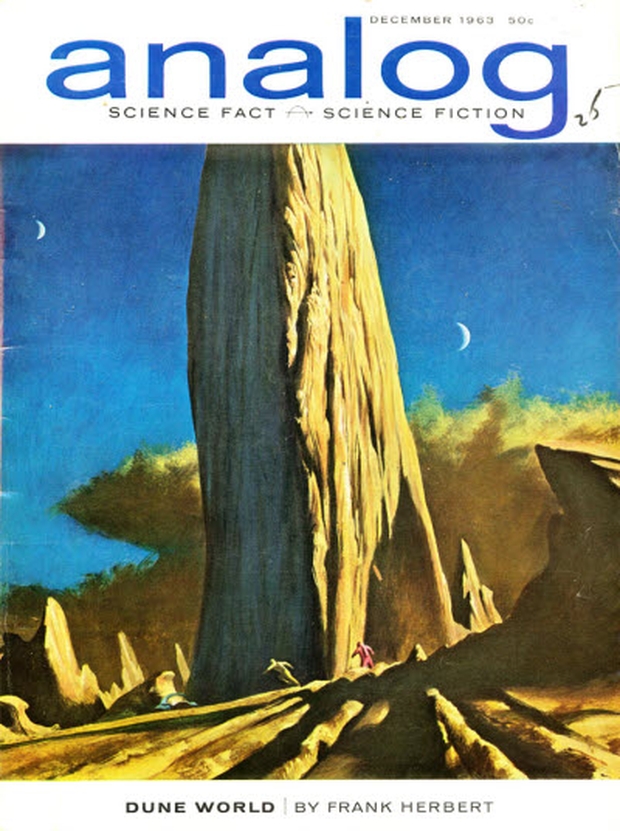
Image: Judging from the comments of many scientists I’ve known, Frank Herbert’s Dune inspired more than a few careers that have led to exoplanet research. The publishing history is lengthy, but here’s the first appearance of the planet Arrakis in “Dune World,” the first half of the original novel, as serialized beginning with the December, 1963 issue of Analog.
The explosion of data on exoplanets, of which there were close to 6000 confirmed as Cooper was wrapping up his manuscript, has induced subtle shifts in science fiction that are acknowledged by writers as well as scientists (and the two not infrequently overlap). I think Cooper is on target as he points out that in the pre-exoplanet discovery era, Earth-like worlds were a bit easier to imagine and use as settings. But we still search for a true Earth analogue in vain.
…it’s probably fair to say that SF before the exoplanet discoveries of the 1990s was biased towards imagining worlds that were like something much closer to home. Alas, comfortably habitable worlds like Earth are, so far, in short supply. Instead, at best, we might be looking at habitable niches rather than whole welcoming worlds. Increasingly, more modern SF reflects this; think of the yin-yang world of unbearable heat and deathly cold from Charlie Jane Anders’s Locus award-winning 2019 novel The City in the Middle of the Night or the dark, cloud-smothered moon LV-426 in Alien (1979) and Aliens (1986) that has to be terraformed to be rendered habitable (although that example actually pre-dates the discovery of exoplanets).
Changes in the background ‘universe’ of a science fiction tale are hardly new. It was in 1928 that Edward E. ‘Doc’ Smith published The Skylark of Space, an award-winning tale which broached the idea that science fiction need not be confined to the Solar System. In the TV era, Star Trek reminded us of this when we suddenly had a show where the Earth was seldom mentioned. Both had some precursors, but the point is that SF adapts to known science but then can make startling imaginative jumps.
Thus novelist Stephen Baxter, a prolific writer with a background in mathematics and engineering:
’Now that we know planets are out there, it’s different because as a writer you’re exploring something that’s already defined to some extent scientifically, but it’s still very interesting…You know the science and might have some data, so you can use all that as opposed to either deriving it or just imagining it.”
What a terrific nexus for discovery and imagination. If you’re been reading science fiction for as long as I have, you’ll enjoy how famous fictional worlds map up against the discoveries we’re making with TESS and JWST. I found particular satisfaction in Cooper’s explorations of Larry Niven’s work, which clearly delights any number of scientists because of its imaginative forays within known physics and the sheer range of planetary settings he deploys.
No wonder fellow SF writers like Alastair Reynolds and Paul MacAuley cite him within these pages as an influence on their subsequent work. Niven, as McAuley points out, can meld Earth-like features with profound differences that breed utterly exotic locales. This is a man who has, after all, written (like Clement and Forward) about extreme environments for astrobiology (think of his The Integral Trees, for example, with hot Jupiters and neutron star life).
And then there’s Ringworld, with its star-encircling band of technology, and the race known as Pierson’s Puppeteers, developed across a range of stories and novels, who engineer a ‘Klemperer Rosette’ out of five worlds, one of them their home star. Each is at the point of a pentagon and all orbit a point with a common angular momentum. Their home world, Hearth, is an ‘ecumenopolis,’ a world-spanning city on the order of Asimov’s Trantor. Here again the fiction pushes the science to come up with explanations. Exoplanet scientist and blogger Alex Howe (NASA GSFC) explains his own interest:
“The Puppeteer’s Hearth is one of the things that keyed me in to the waste heat problem,” says Howe, who is a big fan of Niven: “I describe Larry Niven as re-inventing hard science fiction… not as SF that conforms strictly to known physics, but as SF that invents new physics or perhaps extrapolates from what we currently know, but applies it rigorously.”
Howe is an interesting example of the involvement of scientists with science fiction. A writer himself, he maintains his own blog devoted to the subject and has been working his way through all the classic work in the field. I’ve focused on SF in this review, but need to point out that Cooper’s work is equally strong coming in the non-fictional direction, with productive interviews with leading exoplanetologists. For now that we’re actually studying real planets around other stars, worlds like TOI-1452b, a habitable zone super-Earth around a binary, point to how fictional some of these actual planets seem.
So with known planets as a steadily growing database, we can compare and contrast the two approaches. Thus we meet Amaury Triaud (University of Birmingham), a co-discoverer of the exotic TRAPPIST-1 system and its seven small, rocky worlds. The scientist worked with Nature to coax Swiss SF writer Laurence Suhner into setting a story in that system.
Says Triaud: “If you were in your back garden with a telescope on one of these planets, you’d be able to actually see a city on one of the other planets.” Similarly, the snowball planet Gethen from Ursula le Guin’s The Left Hand of Darkness (1969) is put through analysis by planetary scientist Adiv Paradise (University of Toronto). Thus we nudge into studies of Earth’s own history extrapolated into fictional planets that invoke entirely new questions.
Here’s Paradise on snowball planets and their fate. Must they one day thaw?
“If you have a planet that doesn’t have plate tectonics, and doesn’t have much volcanism, can the carbon dioxide still escape from the outside?… You might end up with a planet where all the carbon dioxide gets locked into the mantle, and volcanism shuts off and you end up with a runaway snowball that might suppress volcanism – we don’t fully understand the feedback between surface temperature and volcanism all that well. In that case, the snowball would become permanent, at least until the star becomes brighter and melts it.”
Cooper’s prose is supple, and it allows him to explain complicated concepts in terms that newcomers to the field will appreciate. Beyond the ‘snowball’ process, the carbonate-silicate cycle so critical to maintaining planetary climates gets a thorough workout, as does the significance of plate tectonics and the consequences if a world does not have this process. Through desert worlds to water worlds to star-hugging M-dwarf planets, we learn about how atmospheres evolve and the methods scientists are using to parse out their composition.

Image: NASA’s playful poster of the TRAPPIST-1 system as a travel destination. Credit: NASA.
Each world is its own story. I hope I’ve suggested the scope of this book and the excitement it conveys even to someone who has been immersed in both science fiction and exoplanetary science for decades. Amazing Worlds of Science Fiction and Science Fact would make a great primer for anyone looking to brush up on knowledge of this or that aspect of exoplanet discovery, and a useful entry point for those just wanting to explore where we are right now.
I also chuckle at the title. Amazing Stories was by consensus the first true science fiction magazine (1926). Analog, once Astounding with its various subtitles, used ‘Science Fiction – Science Fact’ on its cover (I remember taking heat from my brother in law about this, as he didn’t see much ‘fact’ in what I was reading. But then, he wasn’t an SF fan). As a collector of old science fiction magazines, I appreciate Keith Cooper’s nod in their direction.

Claudio Maccone (1948-2025) 22 Aug 7:18 AM (3 months ago)
In all too many ways, I wasn’t really surprised to learn that Claudio Maccone had passed away. I had heard the physicist and mathematician had been in ill health, and because he was a poor correspondent in even the best of times, I was left to more or less assume the worst. His death, though, seems to have been the result of an accident (I’m reminded of the fall that took Freeman Dyson’s life). Claudio and I spent many hours together, mostly at various conferences, where we would have lengthy meals discussing his recent work.
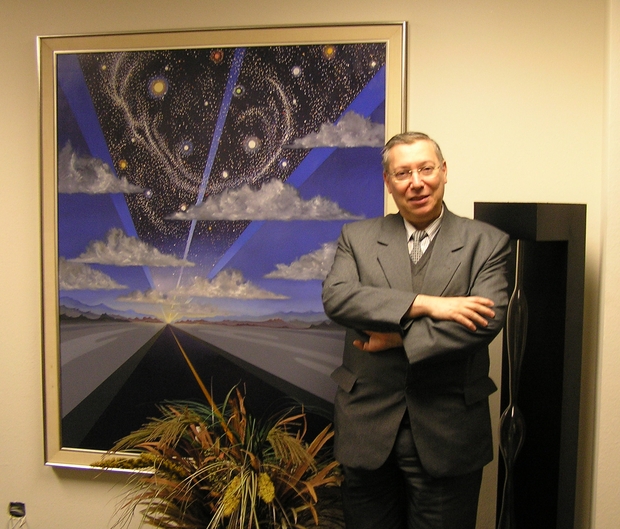
Image: I took this photo of Claudio in Austin, TX in 2009. More on that gathering below.
With degrees in both physics and mathematics from the University of Turin, Claudio received his PhD at King’s College London in 1980. His work on spacecraft design began in 1985, when he joined the Space Systems Group of Alenia Spazio, now Thales Alenia Space Italia, which is where he began to develop ideas ranging from scientific uses for the lunar farside, SETI detections and signal processing, space missions involving sail concepts and, most significantly, a mission to the solar gravitational lens, which is how he and I first connected in 2003.

Coming into the community of deep space scientists as an outsider, a writer whose academic expertise was in far different subjects, I always appreciated the help I received early on from people who were exploring how we might overcome the vast distances between the stars. I had written about Claudio’s ideas on gravitational lensing and the kind of mission that might use it for observation of exoplanets, but was startled to find him waiting at breakfast one morning in Princeton, where Greg Matloff had invited me up for a conference.
Image: At one of the Breakthrough Starshot meetings not long after the project was announced. I took this in the lobby of our hotel in Palo Alto.
Ever the gentleman, Claudio wanted to thank me for my discussion of his work in my Centauri Dreams book, and that breakfast with Greg, his wife C, and Claudio remains a bright memory. As is the conference, chaired by Ed Belbruno, where I made many contacts talking to scientists about their work. I was already writing this site, which began in 2004, and over the years that followed, I would run into Claudio again and again, and not always at major conferences. He appeared, for example, at a founding session of what would grow into the Interstellar Research Group in Oak Ridge, quite a hike from Italy, but when it came to interstellar ideas, Claudio always wanted to be there.

One memorable trip was at Aosta in the Italian Alps, a meeting I particularly cherish because of our meals discussing local history as much as spaceflight. Several of the participants at the Aosta conference had brought their families, and one young boy was fascinated with something Claudio said one night at dinner about Italian history. I’ll never forget his asking Claudio if he could explain what had happened in the Thirty Years War. Claudio didn’t miss a beat. He began talking and in about fifteen minutes had laid out the causes of the conflict between Protestants and Catholics in 17th Century Europe within the context of the Holy Roman Empire, complete with names, dates and details.
I asked him afterwards if he had ever considered a career in history, and it turned out that we both shared an interest especially in Greek and Latin, and that yes, the subject appealed to him, whether it was 17th Century political evolution or the fine points of Pericles’ Funeral Oration. But here he voiced a caution. “You can’t do everything. You just can’t. You have to give so many things up to do your work.” True, of course, and yet somehow his knowledge was that of a polymath. He schooled me on Leibniz over wine and Beef Wellington one night in Dallas, a conversation that went on until late in the evening. In the Italian Alps, he took me into the history of Anselm of Canterbury, who had been born in Aosta, and explained the significance of his philosophy.
Mostly, of course, we talked about space. His fascination with SETI was obvious, and his work on the mathematics of first contact brought the Kosambi–Karhunen–Loève (KLT) theorem into play as a signal processing solution. His work on gravitational lensing and the mission he called FOCAL put that concept in the spotlight, paving the way for later approaches that could solve some of the problems he had identified. A look through the archives here will reveal dozens of articles I’ve written on this and other aspects of his work.

Version 1.0.0
I won’t go into the technical details here – this is a time for recollection more than analysis. But I need to mention that Claudio served as Technical Director for Scientific Space Exploration at the International Academy of Astronautics, a post of which he was rightly proud. Over 100 scientific papers bear his name, as do a number of books, the most influential being Mathematical SETI (2012) and Deep Space Flight and Communications (2009). His ongoing efforts to preserve the lunar farside for astronomical observations remind us of how precious this resource should be in our thinking. Toward the end of his life, he put his mathematical skills to work on the evolution of cultures on Earth and asked whether what he called Evo-SETI could be developed as a way to predict the likelihood of civilizations including our own surviving.
Claudio’s death caused a ripple of comment from people who had worked with him over the years. Greg Matloff, a close friend and colleague, wrote this:
I met Claudio during a Milan solar sail symposium in 1990. We collaborated for years on sails to the solar gravity focus. He was instrumental in my guest professorship in Siena in summer 1994 and my election to IAA. I knew that his health had become a challenge. Apparently, a book shelf had collapsed and he was pinned overnight until his student found him the following morning. I will miss Claudio forever but am glad that I saw him in Luxembourg last December.
I only wish I could have seen Claudio one more time, but it was not to be. I will always honor this good man and thank him for his generosity of spirit, his engaging humor and his willingness to bring me up to speed on concepts that, early on, I found quite a stretch. Now that the concept of a gravitational lensing mission is widespread in the literature and superb work continues at the Jet Propulsion Laboratory on completely new technologies to make this happen, I think Claudio’s place in the history of the interstellar idea is guaranteed.

Image: Claudio Maccone speaking before the United Nations Committee on the Peaceful Uses of Outer Space in Vienna 2010. He was proposing a radio-quiet zone on the farside that will guarantee radio astronomy and SETI a defined area in which human radio interference is impossible. It’s an idea with a pedigree, going back to 1994, when the French radio astronomer Jean Heidmann first proposed a SETI observatory in the farside Saha Crater with a link to the nearside Mare Smythii plain and thence to Earth. Credit: COPUOS.
A final happy memory. Claudio and I had met in Austin Texas and were headed to the Austin Institute for Advanced Studies, to meet with Marc Millis, Eric Davis and Hal Puthoff, among others. Claudio had just bought a new laptop so powerful that it could handle the kind of equations he threw at it. On the way, he bragged about it and showed it to me with delight all over his face.

But the joke was that with facial recognition, it refused to recognize him despite his protracted training of the gadget. I can still hear his normally calm voice gradually growing in volume (the meeting had already started and everyone was taking notes), until finally he burst out with “It’s me, damn you!” We all guffawed, and a few seconds later, amazingly, the computer let him in.
Claudio loved Latin, so here’s a bit from Seneca:
Non est ad astra mollis e terris via.
Which means “There is no easy way from the earth to the stars.”
He certainly would have agreed with that statement, but Claudio Maccone did everything in his power to tackle the problem and show us the possibilities that lay beyond our current technologies. His work was truly a gift to our future.


